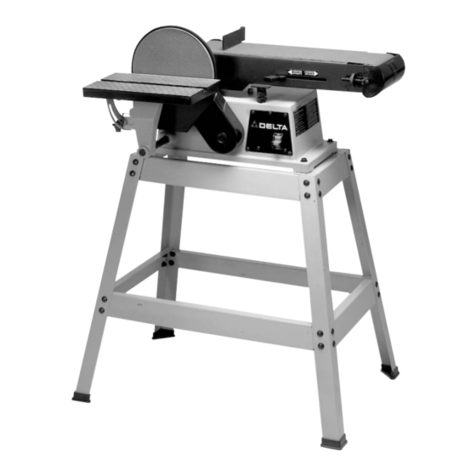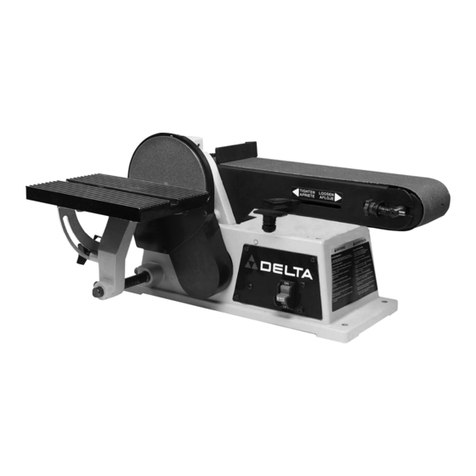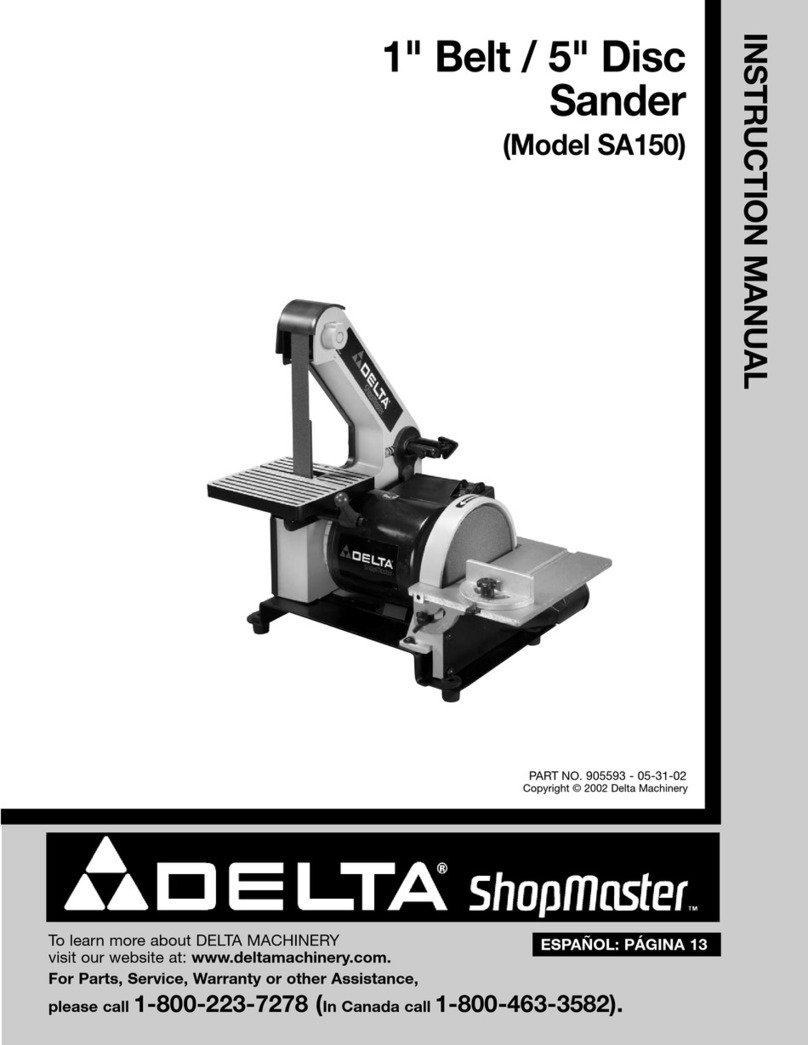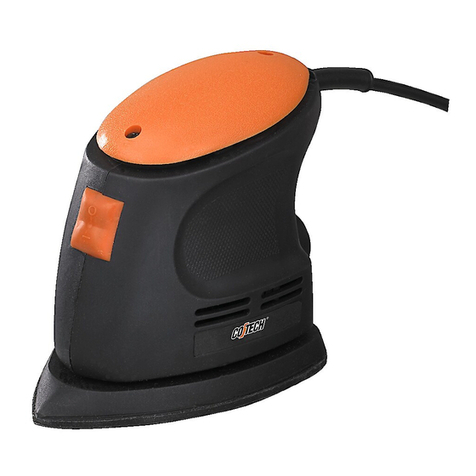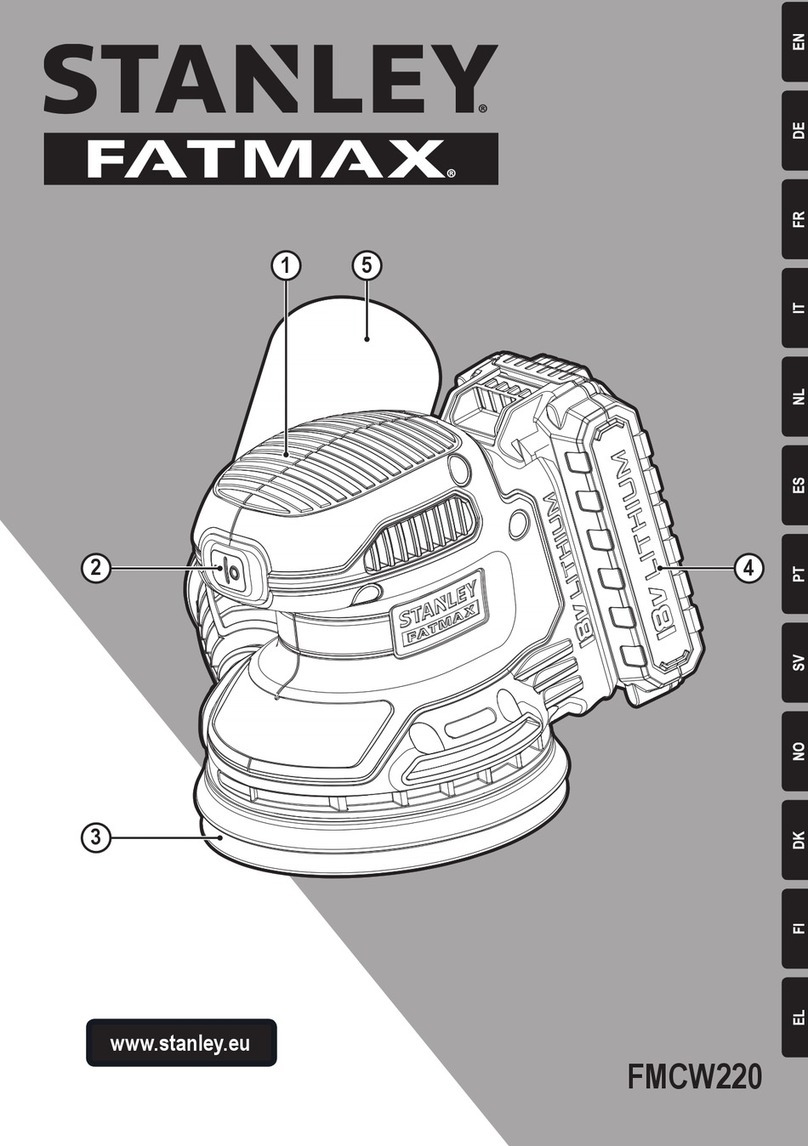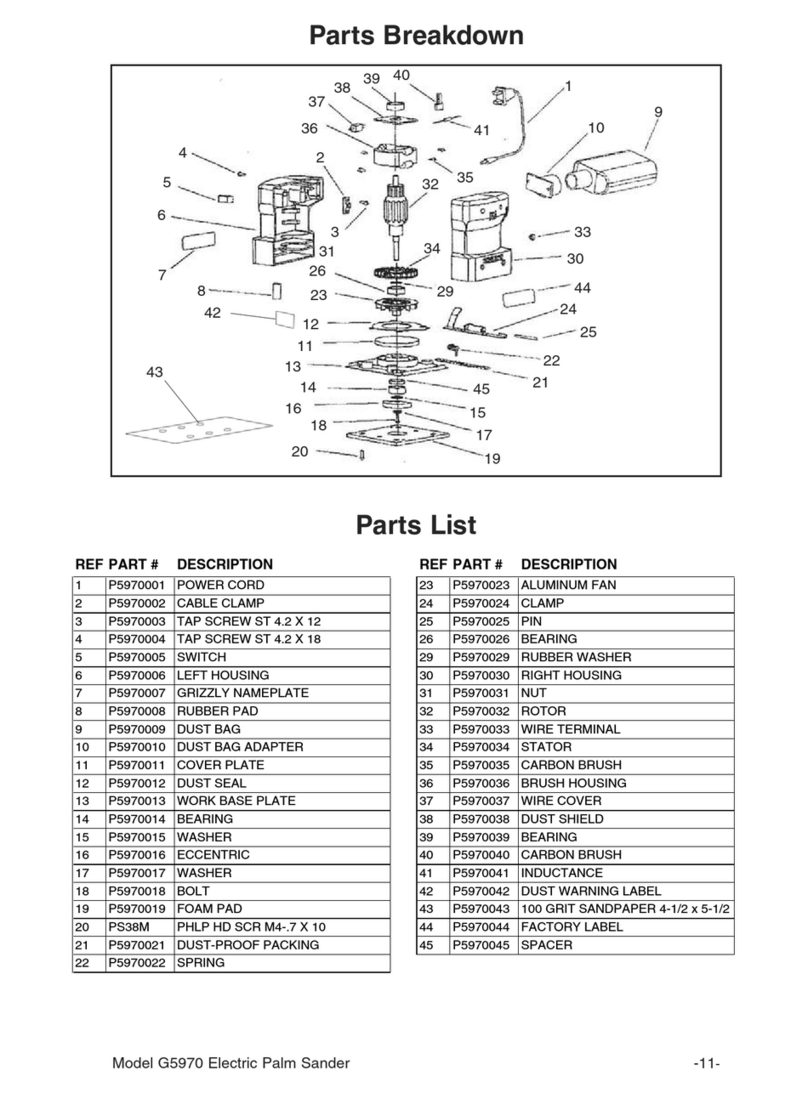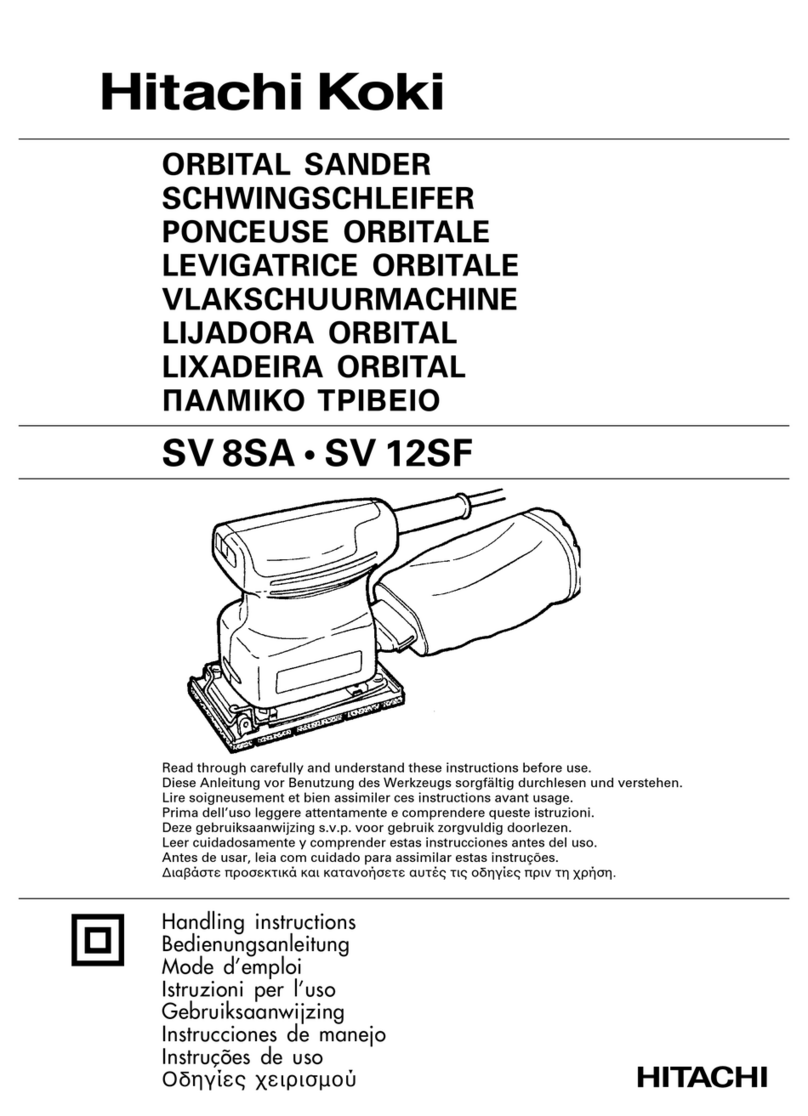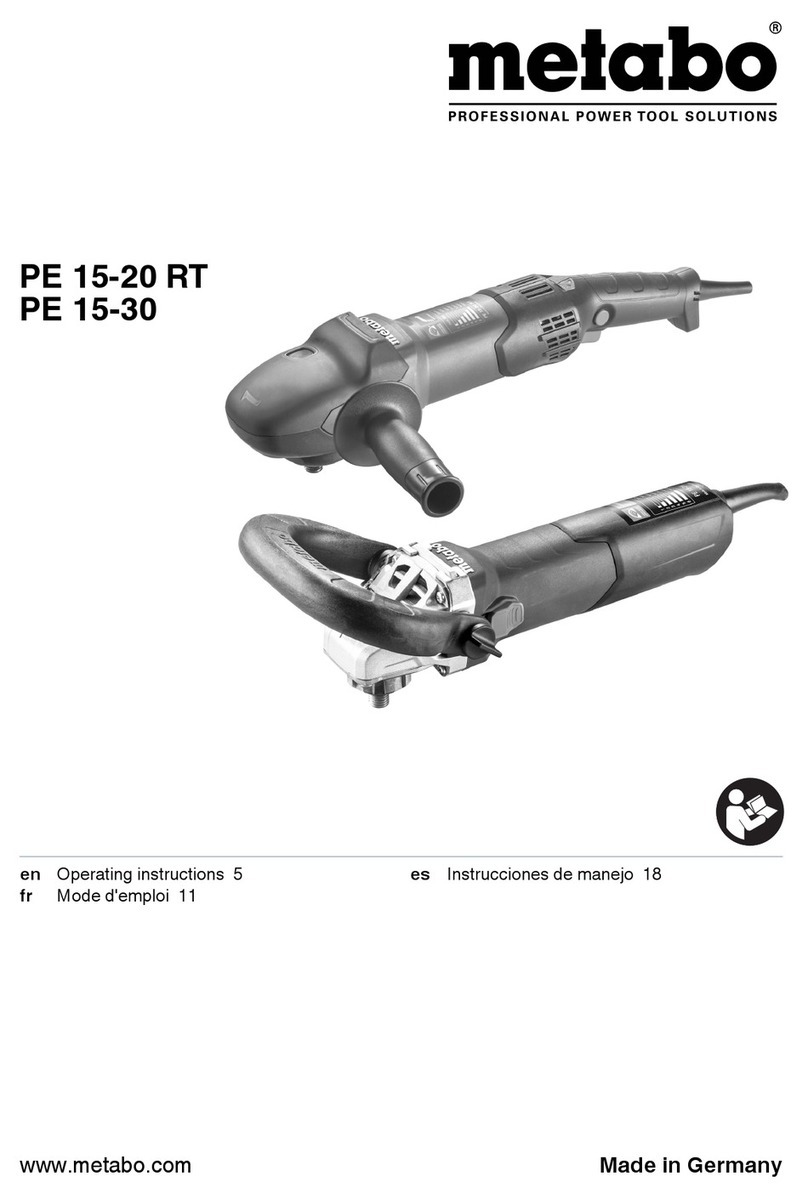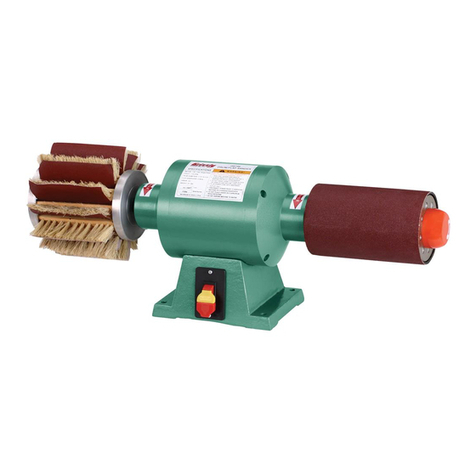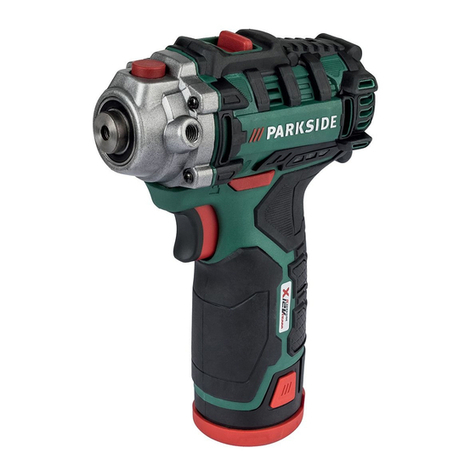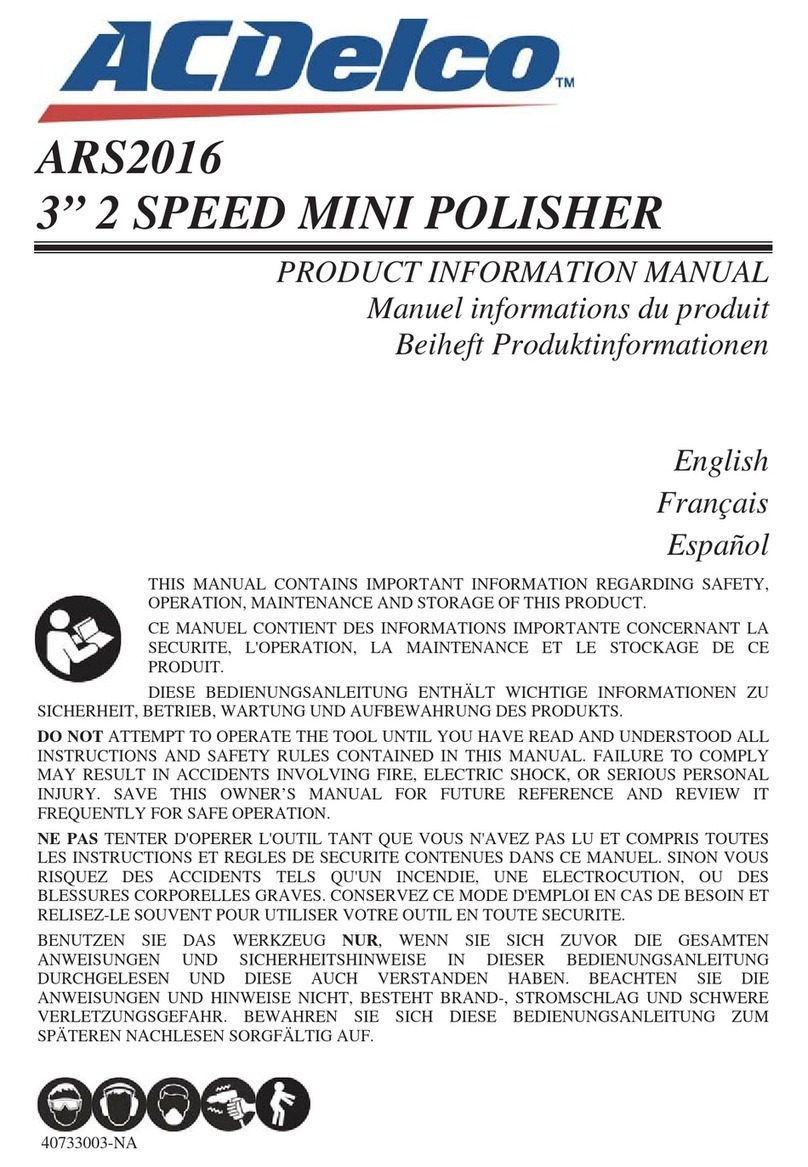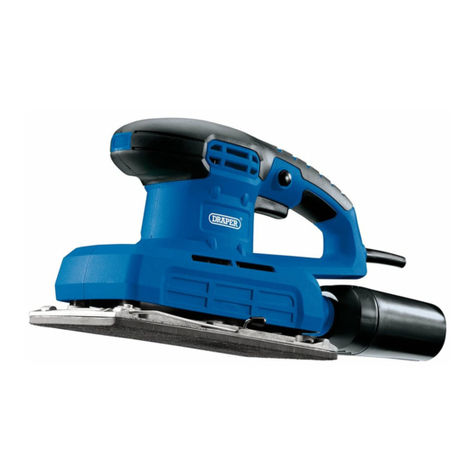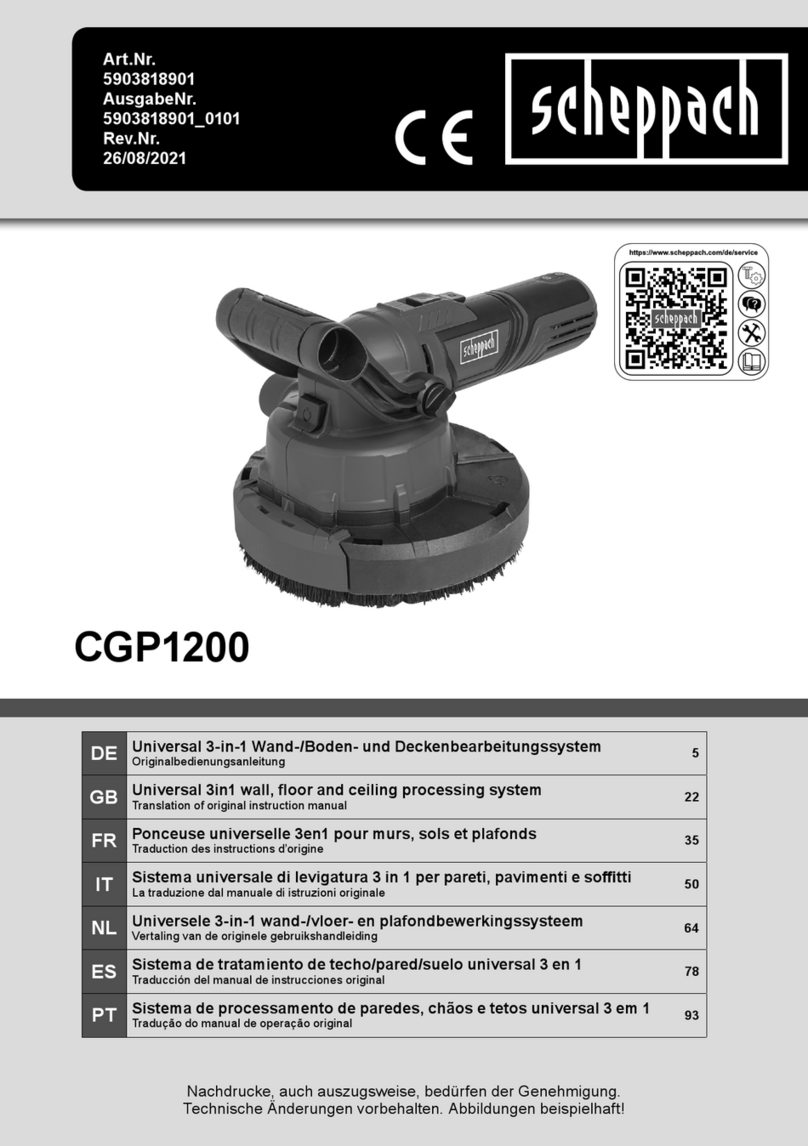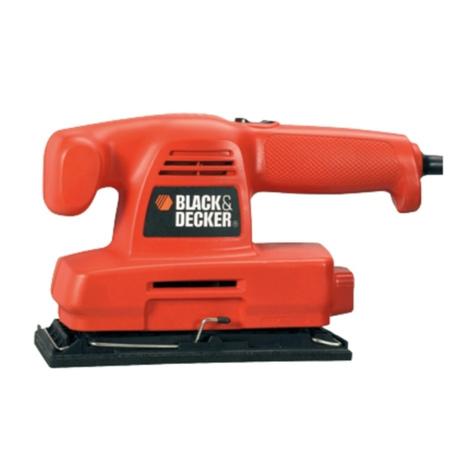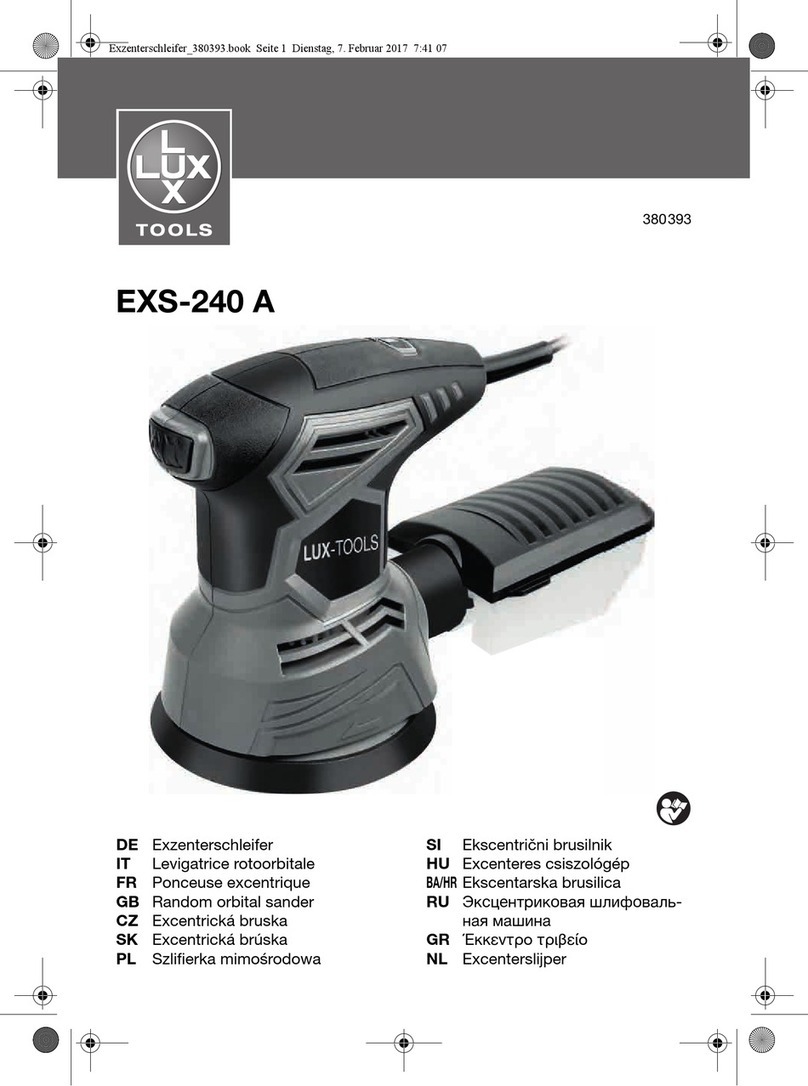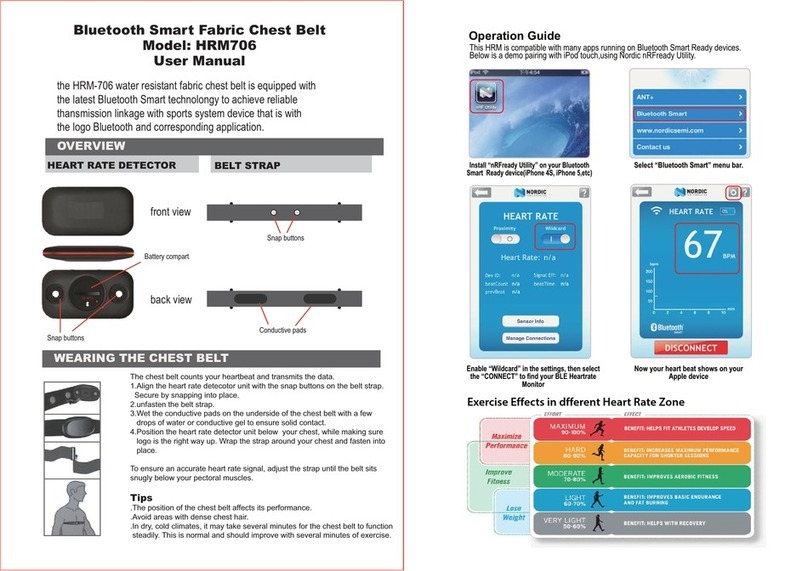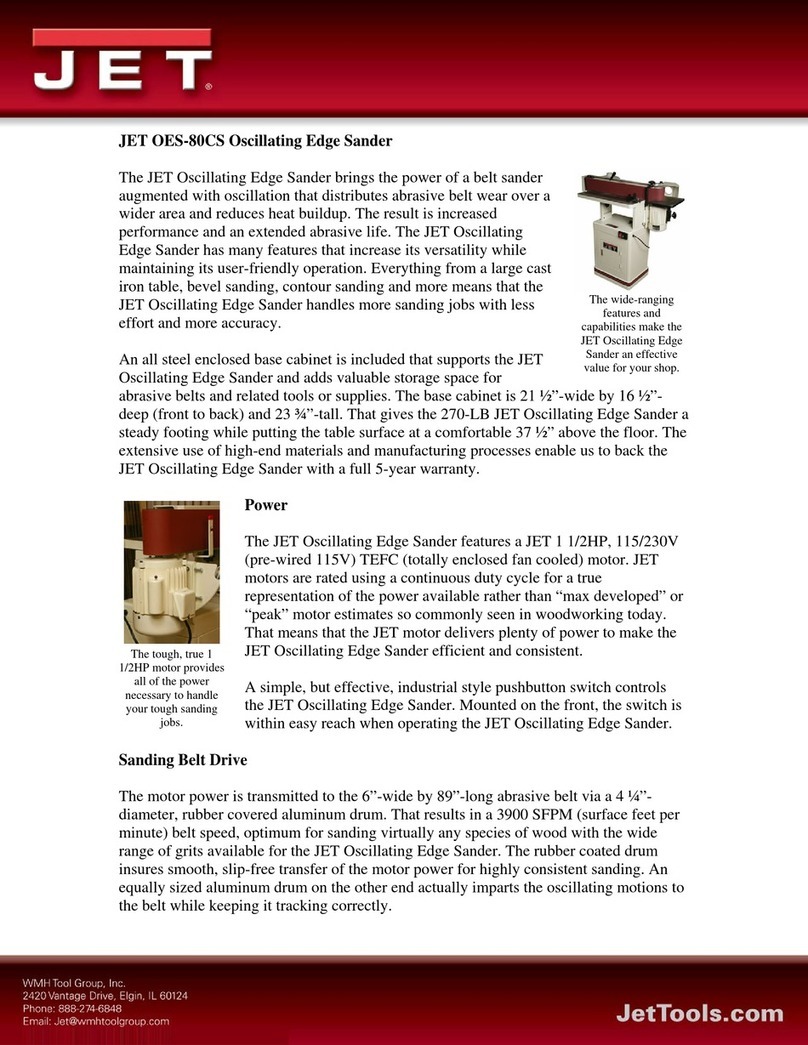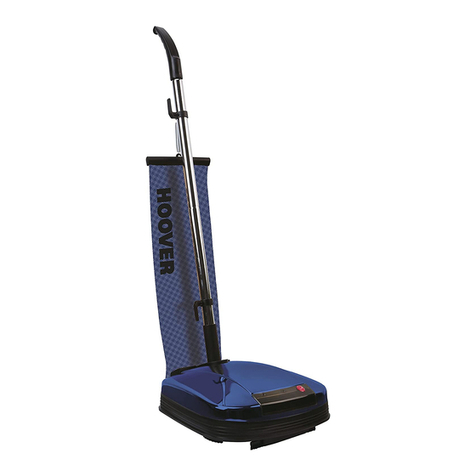Delta 31-495 User manual

Instruction manual
Manuel d’utilisation
Manual de instrucciones
31-495
www.DeltaMachinery.com
Français (12)
Español (22)
INSTRUCTIVO DE OPERACIÓN, CENTROS DE SERVICIO
Y PÓLIZA DE GARANTÍA. LÉASE ESTE
INSTRUCTIVO ANTES DE USAR EL PRODUCTO.
Bench Oscillating
spindle sander
Ponceuse d’établi à
broche oscillante
Lijadora de eje oscilante
de banco

TABLE OF CONTENTS
IMPORTANT SAFETY INSTRUCTIONS .....................2
SAFETY GUIDELINES - DEFINITIONS ......................2
GENERAL SAFETY RULES ........................................3
ADDITIONAL SPECIFIC SAFETY RULES..................4
FUNCTIONAL DESCRIPTION ....................................6
CARTON CONTENTS .................................................6
ASSEMBLY ..................................................................7
OPERATION ................................................................9
TROUBLESHOOTING.................................................10
MAINTENANCE...........................................................10
SERVICE......................................................................10
ACCESSORIES............................................................11
WARRANTY.................................................................11
FRANÇAIS ...................................................................12
ESPAÑOL.....................................................................22
2
IMPORTANT SAFETY INSTRUCTIONS
Read and understand all warnings and operating instructions before using any tool
or equipment. When using tools or equipment, basic safety precautions should always be followed
to reduce the risk of personal injury. Improper operation, maintenance or modification of tools
or equipment could result in serious injury and property damage. There are certain applications
for which tools and equipment are designed. DELTA® Power Equipment Corporation strongly
recommends that this product NOT be modified and/or used for any application other than for which it was
designed.
If you have any questions relative to its application DO NOT use the product until you have written DELTA® Power
Equipment Corporation and we have advised you. Contact us online at www.DeltaMachinery.com or by mail at
Technical Service Manager, DELTA® Power Equipment Corporation, 4825 Highway 45 North, Jackson, TN 38305.
Information regarding the safe and proper operation of this tool is available from the following sources:
• Power Tool Institute, 1300 Sumner Avenue, Cleveland, OH 44115-2851or online at www.powertoolinstitute.org
• National Safety Council, 1121 Spring Lake Drive, Itasca, IL 60143-3201
• American National Standards Institute, 25 West 43rd Street, 4 oor, New York, NY 10036 www.ansi.org - ANSI01.1
Safety Requirements for Woodworking Machines
• U.S. Department of Labor regulations www.osha.gov
SAVE THESE INSTRUCTIONS!
SAFETY GUIDELINES - DEFINITIONS
It is important for you to read and understand this manual. The information it contains relates to protecting YOUR
SAFETY and PREVENTING PROBLEMS. The symbols below are used to help you recognize this information.
Indicates an imminently hazardous situation which, if not avoided, will result in death or
serious injury.
Indicates a potentially hazardous situation which, if not avoided, could result in death or
serious injury.
Indicates a potentially hazardous situation which, if not avoided, may result in minor or
moderate injury.
Used without the safety alert symbol indicates a potentially hazardous situation which, if not
avoided, may result in property damage.
Some dust created by power sanding, sawing, grinding, drilling, and other construction activi-
ties contains chemicals known to cause cancer, birth defects or other reproductive harm. Some
examples of these chemicals are:
• lead from lead-based paints,
• crystalline silica from bricks and cement and other masonry products, and
• arsenic and chromium from chemically-treated lumber.
Your risk from these exposures varies, depending on how often you do this type of work. To reduce your ex-
posure to these chemicals: work in a well ventilated area, and work with approved safety equipment, al ways
wear NIOSH/OSHA approved, properly fit ting face mask or res pi ra tor when us ing such tools.

GENERAL SAFETY RULES
Failure to follow these rules may result in serious personal injury.
3
24.
1. FOR YOUR OWN SAFETY, READ THE INSTRUCTION
MANUAL BEFORE OPERATING THE MACHINE. Learning
the machine’s application, limitations, and specic hazards
will greatly minimize the possibility of accidents and injury.
2. WEAR EYE AND HEARING PROTECTION. ALWAYS USE
SAFETY GLASSES. Everyday eyeglasses are NOT safety
glasses. USE CERTIFIED SAFETY EQUIPMENT. Eye
protection equipment should comply with ANSI Z87.1
standards. Hearing equipment should comply with ANSI
S3.19 standards.
3. WEAR PROPER APPAREL. Do not wear loose clothing,
gloves, neckties, rings, bracelets, or other jewelry which may
get caught in moving parts. Nonslip protective footwear is
recommended. Wear protective hair covering to contain long
hair.
4. DO NOT USE THE MACHINE IN A DANGEROUS
ENVIRONMENT. The use of power tools in damp or wet
locations or in rain can cause shock or electrocution. Keep
your work area well-lit to prevent tripping or placing arms,
hands, and ngers in danger.
5. MAINTAIN ALL TOOLS AND MACHINES IN PEAK
CONDITION. Keep tools sharp and clean for best and
safest performance. Follow instructions for lubricating
and changing accessories. Poorly maintained tools and
machines can further damage the tool or machine and/or
cause injury.
6. CHECK FOR DAMAGED PARTS. Before using the machine,
check for any damaged parts. Check for alignment of
moving parts, binding of moving parts, breakage of parts,
and any other conditions that may affect its operation. A
guard or any other part that is damaged should be properly
repaired or replaced with DELTA® or factory authorized
replacement parts. Damaged parts can cause further
damage to the machine and/or injury.
7. KEEP THE WORK AREA CLEAN. Cluttered areas and
benches invite accidents.
8. KEEP CHILDREN AND VISITORS AWAY. Your shop is a
potentially dangerous environment. Children and visitors
can be injured.
9. REDUCE THE RISK OF UNINTENTIONAL STARTING.
Make sure that the switch is in the “OFF” position before
plugging in the power cord. In the event of a power failure,
move the switch to the “OFF” position. An accidental start-
up can cause injury. Do not touch the plug’s metal prongs
when unplugging or plugging in the cord.
10. USE THE GUARDS. Check to see that all guards are in
place, secured, and working correctly to prevent injury.
11. REMOVE ADJUSTING KEYS AND WRENCHES BEFORE
STARTING THE MACHINE. Tools, scrap pieces, and other
debris can be thrown at high speed, causing injury.
12. USE THE RIGHT MACHINE. Don’t force a machine or
an attachment to do a job for which it was not designed.
Damage to the machine and/or injury may result.
13. USE RECOMMENDED ACCESSORIES. The use of
accessories and attachments not recommended by DELTA®
may cause damage to the machine or injury to the user.
14. USE THE PROPER EXTENSION CORD. Make sure
your extension cord is in good condition. When using an
extension cord, be sure to use one heavy enough to carry
the current your product will draw. An undersized cord will
cause a drop in line voltage, resulting in loss of power and
overheating. See the Extension Cord Chart for the correct
size depending on the cord length and nameplate ampere
rating. If in doubt, use the next heavier gauge. The smaller
the gauge number, the heavier the cord.
15. SECURE THE WORKPIECE. Use clamps or a vise to hold
the workpiece when practical. Loss of control of a workpiece
can cause injury.
16. FEED THE WORKPIECE AGAINST THE DIRECTION OF
THE ROTATION OF THE BLADE, CUTTER, OR ABRASIVE
SURFACE. Feeding it from the other direction will cause the
workpiece to be thrown out at high speed.
17. DON’T FORCE THE WORKPIECE ON THE MACHINE.
Damage to the machine and/or injury may result.
18. DON’T OVERREACH. Loss of balance can make you fall
into a working machine, causing injury.
19. NEVER STAND ON THE MACHINE. Injury could occur if
the tool tips, or if you accidentally contact the cutting tool.
20. NEVER LEAVE THE MACHINE RUNNING UNATTENDED.
TURN THE POWER OFF. Don’t leave the machine until it
comes to a complete stop. A child or visitor could be injured.
21. TURN THE MACHINE “OFF”, AND DISCONNECT THE
MACHINE FROM THE POWER SOURCE before installing
or removing accessories, changing cutters, adjusting or
changing set-ups. When making repairs, be sure to lock the
start switch in the “OFF” position. An accidental start-up
can cause injury.
22. MAKE YOUR WORKSHOP CHILDPROOF WITH
PADLOCKS, MASTER SWITCHES, OR BY REMOVING
STARTER KEYS. The accidental start-up of a machine by a
child or visitor could cause injury.
23. STAY ALERT, WATCH WHAT YOU ARE DOING, AND
USE COMMON SENSE. DO NOT USE THE MACHINE
WHEN YOU ARE TIRED OR UNDER THE INFLUENCE
OF DRUGS, ALCOHOL, OR MEDICATION. A moment of
inattention while operating power tools may result in injury.
USE OF THIS TOOL CAN GENERATE
AND DISBURSE DUST OR OTHER AIRBORNE
PARTICLES, INCLUDING WOOD DUST, CRYSTALLINE
SILICA DUST AND ASBESTOS DUST. Direct particles
away from face and body. Always operate tool in well
ventilated area and provide for proper dust removal.
Use dust collection system wherever possible.
Exposure to the dust may cause serious and permanent
respiratory or other injury, including silicosis (a serious
lung disease), cancer, and death. Avoid breathing the
dust, and avoid prolonged contact with dust. Allowing
dust to get into your mouth or eyes, or lay on your skin
may promote absorption of harmful material. Always
use properly fitting NIOSH/OSHA approved respiratory
protection appropriate for the dust exposure, and wash
exposed areas with soap and water.

ADDITIONAL SPECIFIC SAFETY RULES
Failure to follow these rules may result in serious personal injury.
1. DO NOT OPERATE THIS MACHINE until it is
completely assembled and installed according to the
instructions. A machine incorrectly assembled can
cause serious injury.
2. OBTAIN ADVICE from your supervisor, instructor, or
another qualied person if you are not thoroughly
familiar with the operation of this machine.
3. FOLLOW ALL WIRING CODES and recommended
electrical connections to prevent shock or electrocution.
4. NEVER TURN THE MACHINE “ON” before clearing
the
table/work area of all objects (tools, scraps of wood,
etc.).
5. NEVER TURN THE MACHINE “ON” with the
workpiece contacting the abrasive surface.
6. SECURE THE MACHINE to a supporting surface.
Vibration can cause the machine to slide, walk, or tip
over.
7. REPLACE SLEEVES WHEN WORN OR DAMAGED.
A torn or damaged sleeve could be unexpectedly
expelled from the machine if not replaced
8. PROPERLY SECURE SANDING DRUM on spindle
before operating.
9. DO NOT USE THE MACHINE for wet sanding
applications.
10 CLEAN THE MACHINE and dust collector thoroughly
when processing different types of workpieces (wood,
steel, or aluminum). Combining wood and metal dust
can create an explosion or re hazard.
11. TO REDUCE THE RISK OF FIRE, do not sand or polish
magnesium.
12. HOLD WORKPIECE FIRMLY ON THE SANDER
TABLE. To prevent loss of control use a solid grip.
13. INSPECT MATERIALS FOR DEFECTS. Knots and
splinters can be thrown from the machine with great
force. Make sure defective materials are not used on
this spindle sander.
14. FOREIGN OBJECTS SUCH AS NAILS AND STAPLES
should be removed before sanding.
15. AVOID AWKWARD OPERATIONS AND HAND
POSITIONS. A sudden slip could cause a hand to
contact the abrasive sleeve.
16. KEEP TABLE INSERT IN PLACE. Use correctly sized
table insert for each sanding sleeve to reduce risk of
ngers being pinched or material being pulled down.
1 7. ALWAYS FEED WORKPIECE AGAINST the direction
of the sanding belt rotation.
18. DO NOT SAND very small or very thin workpieces
that cannot be safely controlled. Loss of control of the
workpiece can result in injury.
19. TO MAINTAIN CONTROL, properly support long or
wide work-pieces.
20. NEVER PERFORM LAYOUT, ASSEMBLY, OR SET-
UP WORK on the table/work area when the machine is
running. A sudden slip could cause a hand to move into
the abrasive surface.
21. TURN THE MACHINE “OFF”, disconnect the machine
from the power source, and clean the table/work area
before leaving the machine. LOCK THE SWITCH IN THE
“OFF” POSITION to prevent unauthorized use.
22. ADDITIONAL INFORMATION regarding the safe
and proper operation of power tools (i.e. a safety
video) is available from the Power Tool Institute, 1300
Sumner Avenue, Cleveland, OH 44115-2851 (www.
powertoolinstitute.com). Information is also available
from the National Safety Council, 1121 Spring Lake
Drive, Itasca, IL 60143-3201. Please refer to the
American National Standards Institute ANSI 01.1 Safety
Requirements for Woodworking Machines and the U.S.
Department of Labor OSHA 1910.213 regulations.
SAVE THESE INSTRUCTIONS.
Refer to them often and use them to instruct others.
4

GROUNDED OUTLET BOX
CURRENT
CARRYING
PRONGS
GROUNDING BLADE
IS LONGEST OF THE 3 BLADES
Fig. A Fig. B
GROUNDED OUTLET BOX
GROUNDING MEANS
ADAPTER
POWER CONNECTIONS
A separate electrical circuit should be used for your machines. This circuit should not be less than #12 wire and should
be protected with a 20 Amp time lag fuse. If an extension cord is used, use only 3-wire extension cords which have
3-prong grounding type plugs and matching receptacle which will accept the machine’s plug. Before connecting the
machine to the power line, make sure the switch (s) is in the “OFF” position and be sure that the electric current is of
the same characteristics as indicated on the machine. All line connections should make good contact. Running on low
voltage will damage the machine.
Do not expose the machine to rain or operate the machine in damp locations.
MOTOR SPECIFICATIONS
Your machine is wired for 120 volt, 60 HZ alternating current. Before connecting the machine to the power source,
make sure the switch is in the “OFF” position.
GROUNDING INSTRUCTIONS
This machine must be grounded while in use to protect the operator from electric shock.
1. All grounded, cord-connected machines:
In the event of a malfunction or breakdown, grounding provides a path of least resistance for electric current to
reduce the risk of electric shock. This machine is equipped with an electric cord having an equipment-grounding
conductor and a grounding plug. The plug must be plugged into a matching outlet that is properly installed and
grounded in accordance with all local codes and ordinances.
Do not modify the plug provided - if it will not t the outlet, have the proper outlet installed by a qualied electrician.
Improper connection of the equipment-grounding conductor can result in risk of electric shock. The conductor with
insulation having an outer surface that is green with or without yellow stripes is the equipment-grounding conductor.
If repair or replacement of the electric cord or plug is necessary, do not connect the equipment-grounding conductor
to a live terminal.
Check with a qualied electrician or service personnel if the grounding instruction are not completely understood, or
if in doubt as to whether the machine is properly grounded.
Use only 3-wire extension cords that have 3-prong grounding type plugs and matching 3-conductor receptacles that
accept the machine’s plug, as shown in Fig. A. Repair or replace damaged or worn cord immediately.
2. Grounded, cord-connected machines intended for use on a supply circuit having a nominal rating less than
150 volts:
If the machine is intended for use on a circuit that has an outlet that looks like the one illustrated in Fig. A , the
machine will have a grounding plug that looks like the plug illustrated in Fig. A. A temporary adapter, which looks like
the adapter illustrated in Fig. B may be used to connect this plug to a matching 2-conductor receptacle as shown
in Fig. B, if a properly grounded outlet is not available. The temporary adapter should be used only until a properly
grounded outlet can be installed by a qualied electrician. The green-colored rigid ear, lug, and the like, extending
from the adapter must be connected to a permanent ground such as a properly grounded outlet box. Whenever the
adapter is used, it must be held in place with a metal screw.
NOTE: In Canada, the use of a temporary adapter is not permitted by the Canadian Electric Code.
In all cases, make certain that the receptacle in question is properly grounded. If you are not sure,
have a qualified electrician check the receptacle.
5

MINIMUM GAUGE EXTENSION CORD
RECOMMENDED SIZES FOR USE WITH STATIONARY ELECTRIC MACHINES
Total
Ampere
Rating
0-6
0-6
0-6
0-6
6-10
6-10
6-10
6-10
10-12
10-12
10-12
10-12
12-16
12-16
12-16
Volts
120
120
120
120
120
120
120
120
120
120
120
120
120
120
120
Length of
Cord in
Feet
up to 25
25-50
50-100
100-150
up to 25
25-50
50-100
100-150
up to 25
25-50
50-100
100-150
up to 25
25-50
Gauge of Extension
Cord
18 AWG
16 AWG
16 AWG
14 AWG
18 AWG
16 AWG
14 AWG
12 AWG
16 AWG
16 AWG
14 AWG
12 AWG
14 AWG
12 AWG
GREATER THAN 50 FEET NOT RECOMMENDED
Fig. C
FUNCTIONAL DESCRIPTION
CARTON CONTENTS
2
1
20
4
3
15
11
19
5
10
14
18
6
9
7
8
13
17
12
16
EXTENSION CORDS
Use proper extension cords. Make
sure your extension cord is in good condition and is a
3-wire extension cord which has a 3-prong grounding
type plug and matching receptacle which will accept
the machine’s plug. When using an extension cord,
be sure to use one heavy enough to carry the current
of the machine. An undersized cord will cause a
drop in line voltage, resulting in loss of power and
overheating. Fig. C shows the correct gauge to use
depending on the cord length. If in doubt, use the
next heavier gauge. The smaller the gauge number,
the heavier the cord.
FOREWORD
The DELTA® Model 31-495 has a large 18” diameter
castiron table to support large workpieces. This machine
has a heavy-duty motor assembly with a 1/4 H.P. direct
drive induction motor for quiet, and smooth operation.
NOTICE: The photo on the manual cover illustrates the current production model. All other illustrations contained in the
manual are representative only and may not depict the actual labeling or accessories included. These are intended to
illustrate technique only.
1. Bench Oscillating Spindle Sander
2. 3/4” Sanding Drum & Abrasive Sleeve
3. Table insert for the 3/4” Assembly
4. Table insert for the 3” Assembly
5. Table insert for the 2”” Assembly
6. Table insert for the 1-1/2” Assembly
7. Table insert for the 1” Assembly
8. 1” Sanding Drum & Abrasive Sleeve
9. 1-1/2 Sanding Drum & Abrasive Sleeve
10. 2” Sanding Drum & Abrasive Sleeve
11. 3” Sanding Drum & Abrasive Sleeve
12. 1” O.D. Drum Washer
13. 1-1/2” O.D. Drum Washer
14. 2” O.D. Drum Washer
15. 3” O.D. Drum Washer
16. Arbor Screw
17. 3/16” Hex Wrench
18. 1/2” Socket Wrench
19. Spindle Adapter
20. Dust Bag
UNPACKING AND CLEANING
Carefully unpack the machine and all loose items from the shipping container(s). Remove the rust-preventative oil from
unpainted surfaces using a soft cloth moistened with mineral spirits, paint thinner or denatured alcohol.
Do not use highly volatile solvents such as gasoline, naphtha, acetone or lacquer thinner for cleaning your machine.
After cleaning, cover the unpainted surfaces with a good quality household oor paste wax.
6

ASSEMBLY
A
FIG. 1 FIG. 2
A
B
FIG. 3
B
D E D
FIG. 4
For your own safety, do not connect the machine to the power source until the machine is
completely assembled and you read and understand the entire instruction manual.
ASSEMBLY TOOLS REQUIRED
3/16” Hex Wrench (Supplied) 1/2” Socket Wrench
(Supplied) 7/16’ open-end wrench
ASSEMBLY TIME ESTIMATE
Assembly for this machine takes less than 1/2 hour.
1. Carefully turn the machine upside down. Place it on a clean, rm, supporting surface.
2. Use a at-head screwdriver or similar device to remove the plug (A) Fig. 1 to gain access to socket-head screw (not
shown).
3. Carefully place the machine on its side (Fig. 2). Attach the spindle adapter (B) Fig. 2 to the motor shaft (A) by
turning the spindle adapter counter-clockwise on the shaft.
NOTE: Motor shaft has a left-hand thread.
4. Place a 7/16” open-end wrench (D) Fig. 3 (not sup plied) on the ats of spindle adapter (B). Insert a 3/16” hex
wrench (E) Fig. 3 (supplied) into the socket-head screw located where the plug (A) Fig. 1 was removed in STEP 2.
5. Hold the hex wrench (E) Fig. 4 to prevent the motor shaft from turning. Turn the wrench (D) coun ter -clock wise to
fasten the spindle adapter on the motor shaft.
6. Install the plug (A) Fig. 1 that was removed in STEP 2.
7

FIG. 10
B
E
C
D
A F
G
FIG. 5
FIG. 7
F
D
G
G
C
H
FIG.8
A
FIG. 9
A
FIG. 11
FIG. 6
C
D
E
ATTACHING THE SANDING DRUM, ABRASIVE SLEEVE AND TABLE INSERT
1. Select the correct abrasive sleeve for your workpiece.
2. Slide that abrasive sleeve (C) Figs. 5 and 6 over the matching sanding drum (D) Figs. 5 and 6. Position this
assembly on the spindle adapter. Place the matching washer (A) Fig. 5 on top of the assembly and fasten it with
a 5/16” screw (E) Fig. 5, using the socket wrench (F) Fig. 7.
NOTE: Turn the screw (E) Fig. 5 counter-clockwise to tighten and clockwise to loosen.
3. Place the table insert (G) Figs. 7 & 8 over the abrasive sleeve (C) and in the cut-out on the table.
NOTE: Arrows on the table insert indicate the top surface.
4. Use the compartments (H) Fig. 8 on the sides of the sander for storing workpieces or accessories.
ATTACHING THE DUST BAG
To attach the dust bag (B) Fig. 10 to the 1-1/2”dust chute (A) Fig. 9, squeeze the spring clamp on the dust bag and
slide it over the dust chute. Release the clamp.
FASTENING THE SANDER TO A SUPPORTING SURFACE
If the machine has any tendency to tip over, slide, or
walk on the supporting surface, you must secure the
machine base to the supporting surface. Use the four
holes, three of which are shown at (A) Fig. 11 to attach
the machine to the supporting surface.
8

OPERATION
OPERATIONAL CONTROLS AND ADJUSTMENTS
A
FIG. 11
FIG. 13
B
A
FIG. 14
B
A
FIG. 15
C
D
E
F
STARTING AND STOPPING THE SANDER
The on/off switch (A) Fig. 12 is located on the sander
base.To turn the sander “ON”, move the switch up to the
“ON” position.To turn the sander “OFF”, move the switch
down to the “OFF” position.
LOCKING THE SWITCH IN THE “OFF” POSITION
IMPORTANT: When the machine is not in use, the
switch should be locked in the “OFF” position to
prevent unauthorized use. To lock the machine, grasp
the switch toggle (B) and pull it out of the switch (Fig. 13).
With the switch toggle (B) removed, the switch will not
operate. However, should the switch toggle be removed
while the sander is running, the machine can be turned
“OFF,” but cannot be restarted without re-inserting the
switch toggle (B).
ADJUSTING THE SPINDLE ASSEMBLY
If excessive play develops in the spindle assembly, or
if noise level increases after extended use, adjust the
spindle assembly.
Disconnect the machine from the
power source!
1. Turn the machine over and place it on a rm supporting
surface.Be careful not to damage the spindle assembly.
2. Remove the four mounting screws (A) Fig. 14. Remove
the case (B) from the machine.
3. IMPORTANT: Position the shaft (C) Fig. 15 inside the
center of the bracket (D). To adjust, loosen the two lock
nuts (E) Fig. 15. Tighten or loos en the two adjusting
screws (F) until the shaft (C) is centered inside the
bracket (D) with the adjustment screws (F) contacting
the shaft. Tighten the two locknuts (E) Fig. 15.
4. Secure the case with the four screws removed in STEP
3.
9

FIG. 16
MACHINE USE
TROUBLESHOOTING
MAINTENANCE
SERVICE
A
B
FIG. 17
Sanding inside curves is illustrated in Fig. 16.
IMPORTANT: Always sand against the rotation of the
sanding drum.
The oscillating action of the sanding drum minimizes
score marks and prevents clogging of the sanding drum,
providing faster, smoother sanding and increasing
the life of the sanding sleeve.
For assistance with your machine, visit our website at www.DeltaMachinery.com for a list of service centers or call the
DELTA Power Equipment Corporation help line at 1-800-223-7278.
KEEP MACHINE CLEAN
Periodically blow out all air passages with dry compressed air. All plastic parts should be cleaned with a soft damp
cloth. NEVER use solvents to clean plastic parts. They could possibly dissolve or otherwise damage the material.
Wear certified safety equipment for eye, hearing and respiratory protection while using compressed air.
After 100 hours of use, Change the grease in the gear
housing.
To gain access to the gear housing:
Disconnect the machine from the
power source!
1. T urn the machine over and loosen the two screws
(A Fig. 17 and remove the cover (B).
2. Remove the old grease and repack the gears
with new grease.
3. Replace the cover.
FAILURE TO START
Should your machine fail to start, check to make sure the prongs on the cord plug are making good contact in the
outlet. Also, check for blown fuses or open circuit breakers in the line.
LUBRICATION & RUST PROTECTION
Apply household oor paste wax to the machine table, extension table or other work surface weekly. Or use a commer-
cially available protective product designed for this purpose. Follow the manufacturer’s instructions for use and safety.
To clean cast iron tables of rust, you will need the following materials: a sheet of medium Scotch-Brite™ Blending
Hand Pad, a can of WD-40® and a can of degreaser. Apply the WD-40 and polish the table surface with the Scotch-
Brite pad. Degrease the table, then apply the protective product as described above.
REPLACEMENT PARTS
Use only identical replacement parts. For a parts list or to order parts, visit our website at www.DeltaMachinery.com/service.
You can also order parts from your nearest factory-owned branch, or by calling our Customer Care Center at 1-800-223-7278
to receive personalized support from highly-trained technicians.
10

ACCESSORIES
Five Year Limited New Product Warranty
DELTA will repair or replace, at its expense and at its option, any new DELTA machine, machine part, or machine accessory which in nor-
mal use has proven to be defective in workmanship or material, provided that the customer returns the product prepaid to a DELTA fac-
tory service center or authorized service station with proof of purchase of the product within five years and provides DELTA with reason-
able opportunity to verify the alleged defect by inspection. For all refurbished DELTA product, the warranty period is 180 days. DELTA will
not be responsible for any asserted defect which has resulted from normal wear, misuse, abuse or repair or alteration made or specifically
authorized by anyone other than an authorized DELTA service facility or representative. Under no circumstances will DELTA be liable for
incidental or consequential damages resulting from defective products. Some states do not allow the exclusion or limitation of incidental
or consequential damages, so the above limitation or exclusion may not apply to you. This warranty is DELTA’s sole warranty and sets
forth the customer’s exclusive remedy, with respect to defective products; all other warranties, express or implied, whether of merchant-
ability, fitness for purpose, or otherwise, are expressly disclaimed by DELTA. For further detail of warranty coverage and warranty repair
information, visit www.DeltaMachinery.com or call 1-800-223-7278. This warranty gives you specific legal rights and you may have other
rights which vary in certain states or provinces.
WARRANTY
TO REDUCE THE RISK
OF INJURY KEEP
HANDS AWAY FROM
MOVING PARTS
PARA REDUCIR EL RIESGO DE
LESIONES MANTENGA LAS
MANOS LEJOS DE LAS
PIEZAS EN MOVIMIENTO
AFIN DE RÉDUIRE LE RISQUE DE
BLESSURES ÉLOIGNER LES MAINS
DES PIÈCES MOBILES
A21636
SERVICE AND REPAIRS
FREE WARNING LABEL REPLACEMENT
If your warning labels become illegible or are missing, call 1-800-223-7278 for a free replacement.
All quality tools will eventually require servicing and/or replacement of parts. For information about DELTA® Power Equipment
Corporation, its factoryowned branches, or an Authorized Warranty Service Center, visit our website at www.DeltaMachinery.
com or call our Customer Care Center at 1-800-223-7278. All repairs made by our service centers are fully guaranteed against
defective material and workmanship. We cannot guarantee repairs made or attempted by others.
You can also write to us for information at DELTA® Power Equipment Corporation, 4825 Highway 45 North, Jackson, Tennessee
38305 - Attention: Product Service. Be sure to include all of the information shown on the nameplate of your tool (model
number, type, serial number, etc.)
A complete line of accessories is available from your DELTA® Supplier, Factory Service Centers, and DELTA® Authorized
Service Centers. Please visit our Web Site www.DeltaMachinery.com for an online catalog or for the name of your
nearest supplier.
Since accessories other than those offered by DELTA® have not been tested with this product,
use of such accessories could be hazardous. For safest operation, only DELTA® recommended accessories
should be used with this product.
To register your tool for warranty service visit our website at www.DeltaMachinery.com.
11

MESURES DE SÉCURITÉ - DÉFINITIONS
LES INSTRUCTIONS IMPORTANTES DE SURETE
La poussière produite par le ponçage électrique le sciage, le meulage, le perçage et autres
activités de construction peut contenir des produits chimiques qui sont reconnus, par l’état de la Californie, de causer
le cancer, les anomalies congénitales ou autres maux de reproduction. Ces produits chimiques comprennent, entre
autres :
• le plomb provenant des peintures à base de plomb;
• la silice cristalline provenant de briques, de béton ou d’autres produits de maçonnerie
• l’arsenic et le chrome provenant du bois de charpente traité chimiquement
Le risque d’exposition à ces produits dépend de la fréquence d’exécution de ce genre de travaux. An de réduire l’exposition
à ces produits chimiques, travaillez dans un endroit bien aéré et utilisez de l’équipement de sécurité approuvé, portez toujours
un masque facial ou respirateur homologué MSHA/NIOSH bien ajusté lorsque vous utilisez de tels outils.
CONSERVEZ CES INSTRUCTIONS!
Lire et comprendre toutes instructions d’avertissements et opération avant
d’utiliser n’importe quel outil ou n’importe quel équipement. En utilisant les outils ou l’équipement, les
précautions de sûreté fondamentales toujours devraient être suivies pour réduire le risque de blessure
personnelle. L’opération déplacée, l’entretien ou la modification d’outils ou d’équipement ont pour
résultat la blessure sérieux et les dommages de propriété. Il y a de certaines applications pour lequel
outils et l’équipement sont conçus. La DELTA® Power Equipment Corporation recommande avec force que ce
produit n’ait pas modifié et/ou utilisé pour l’application autrement que pour lequel il a été conçu.
Si vous avez n’importe quelles questions relatives à son application n’utilisent pas le produit jusqu’à ce que vous avez
écrit DELTA® Power Equipment Corporation et nous vous avons conseillé. La forme en ligne de contact à www.
DeltaMachinery.com Courrier Postal: Technical Service Manager, DELTA® Power Equipment Corporation, 4825 Highway
45 North, Jackson, TN 38305.
Information en ce qui concerne l’opération sûre et correcte de cet outil est disponible des sources suivantes:
• Power Tool Institute, 1300 Sumner Avenue, Cleveland, OH 44115-2851 ou en ligne www.powertoolinstitute.org
• National Safety Council, 1121 Spring Lake Drive, Itasca, IL 60143-3201
• American National Standards Institute, 25 West 43rd Street, 4 oor, New York, NY 10036 www.ansi.org - ANSI 01.1
Safety Requirements for Woodworking Machines
• U.S. Department of Labor regulations www.osha.gov
Ce guide contient des renseignements importants que vous deviez bien saisir. Cette information porte sur VOTRE SÉCURITÉ
et sur LA PRÉVENTION DE PROBLÈMES D’ÉQUIPEMENT. An de vous aider à identier cette information, nous avons
utilisé les symboles ci-dessous. Veuillez lire attentivement ce guide en portant une attention particulière à ces sections.
ou la mort.
Indique un danger imminent qui, s’il n’est pas évité, causera de graves blessures ou la mort.
Indique la possibilité d’un danger qui, s’il n’est pas évité, pourrait causer de graves blessures
Indique la possibilité d’un danger qui, s’il n’est pas évité, peut causer des dommages à la propriété.
Sans le symbole d’alerte.Indique la possibilité d’un danger qui, s’il n’est pas évité, peut causer des
dommages; mineures ou moyennes.
12

RÈGLES DE SÉCURITÉ GÉNÉRALES
L’inobservation de ces règles peut conduire à des blessures graves.
1. POUR SA SÉCURITÉ PERSONNELLE, LIRE LA NOTICE
D’UTILISATION, AVANT DE METTRE LA MACHINE EN
MARCHE, et pour aussi apprendre l’application et les limites de
la machine ainsi que les risques qui lui sont particuliers ainsi, les
possibilités d’accident et de blessures seront beaucoup réduites.
2. PORTEZ DES DISPOSITIFS DE PROTECTION DES YEUX
ET DE L’OUÏE. UTILISEZ TOUJOURS DES LUNETTES
DE SÉCURITÉ. Des lunettes ordinaires ne constituent PAS
des lunettes de sécurité. UTILISEZ DES ÉQUIPEMENTS DE
SÛRETÉ HOMOLOGUÉS. Les dispositifs de protection des yeux
doivent être conformes aux normes ANSI Z87.1. Les dispositifs
de protection de l’ouïe doivent être conformes aux normes ANSI
S3.19.
3. PORTER UNE TENUE APPROPRIÉE. Pas de cravates, de gants,
ni de vêtements amples. Enlever montre, bagues et autres bijoux.
Rouler les manches. Les vêtements ou les bijoux qui se trouvent
pris dans les pièces mobiles peuvent entraîner des blessures.
4. NE PAS UTILISER LA MACHINE DANS UN ENVIRONNEMENT
DANGEREUX. L’utilisation d’outils électriques dans des endroits
humides ou sous la pluie peut entraîner des décharges électriques
ou une électrocution. Garder la zone de travail bien éclairée pour
éviter de trébucher ou d’exposer les doigts, les mains ou les bras à
une situation dangereuse.
5. GARDER LES OUTILS ET LES MACHINES EN PARFAIT ÉTAT.
Garder les outils affûtés et propres an d’obtenir le meilleur et
le plus sûr rendement. Suivre les instructions pour lubrier et
changer les accessoires. Les outils et les machines mal entretenus
peuvent se dégrader davantage, et/ou entraîner des blessures.
6. INSPECTER LES PIÈCES POUR DÉCELER TOUT DOMMAGE.
Avant d’utiliser la machine, la vérier pour voir s’il n’y a pas de
pièces endommagées. Vérier l’alignement des pièces mobiles et
si ces pièces ne se coincent pas, la rupture de pièces, ou toute
autre condition pouvant en affecter le fonctionnement. Toute pièce
ou protecteur endommagé doit être réparé ou remplacé. Les
pièces endommagées peuvent dégrader davantage la machine et/
ou entraîner des blessures.
7. GARDER L’AIRE DE TRAVAIL PROPRE. Les zones et établis
encombrés favorisent les accidents.
8. GARDER LES ENFANTS ET LES VISITEURS À DISTANCE.
L’atelier est un lieu potentiellement dangereux. Les enfants et les
visiteurs peuvent se blesser.
9. ÉVITER LE DÉMARRAGE ACCIDENTEL. S’assurer que
l’interrupteur est sur « OFF » (ARRÊT) avant de brancher le cordon.
En cas de coupure de courant, placer l’interrupteur à la position
« OFF » (ARRÊT). Un démarrage accidentel peut entraîner des
blessures.
10. UTILISER LES DISPOSITIFS PROTECTEURS. Vérier que tous
les dispositifs protecteurs sont bien en place, bien xés et en bon
état de marche pour éviter les blessures.
11. ENLEVER LES CLÉS DE RÉGLAGE ET CELLES DE SERRAGE
AVANT DE METTRE LA MACHINE EN MARCHE. Les outils, les
chutes et les autres débris peuvent être projetés violemment et
blesser.
12. UTILISER LA BONNE MACHINE. Ne pas forcer la machine ou
l’accessoire à faire un travail pour lequel il n’a pas été conçu. Des
dommages à la machine et/ou des blessures pourraient s’ensuivre.
13. UTILISER LES ACCESSOIRES RECOMMANDÉS. L’utilisation
d’accessoires non recommandés par DELTA® peut endommager
la machine et blesser l’utilisateur.
14. UTILISER LE CORDON PROLONGATEUR APPROPRIÉ.
S’assurer que le cordon prolongateur est en bon état. Lorsqu’un
cordon prolongateur est utilisé, s’assurer que celui-ci est d’un
calibre sufsant pour l’alimentation nécessaire à la machine. Un
cordon d’un calibre insufsant entraînera une perte de tension
d’où une perte de puissance et surchauffe. Voir le tableau sur les
cordons prolongateurs pour obtenir le calibre approprié selon la
longueur du cordon et l’ampérage de la machine. S’il y a un doute,
utiliser un cordon d’un calibre supérieur. Plus le chiffre est petit,
plus le l est gros.
15. FIXER LA PIÈCE. Utilisez les brides ou l’étau quand vous ne
pouvez pas xer l’objet sur la table et contre la barrière à la main
ou quand votre main sera dangereusement près de la lame (à
moins de 6”).
16. AVANCER LA PIÈCE DANS LE SENS CONTRAIRE À LA
ROTATION DE LA LAME, DE LA FRAISE OU DE LA SURFACE
ABRASIVE. L’alimentation dans l’autre sens peut entraîner une
projection violente de la pièce.
17. NE PAS FORCER LA MACHINE EN AVANÇANT LA PIÈCE
TROP VITE. Des dommages et/ou des blessures peuvent
s’ensuivre.
18. NE PAS SE PENCHER AU-DESSUS DE LA MACHINE. Une
perte de l’équilibre peut entraîner une chute sur la machine en
marche et causer des blessures.
19. NE JAMAIS MONTER SUR LA MACHINE. On peut se
blesser gravement si la machine bascule ou si l’on touche
accidentellement son outil tranchant.
20. NE JAMAIS LAISSER LA MACHINE EN MARCHE SANS
SURVEILLANCE. COUPER LE COURANT. Ne pas quitter la
machine tant qu’elle n’est pas complètement arrêtée. Un enfant ou
un visiteur pourrait se blesser.
21. METTRE LA MACHINE À L’ARRÊT « OFF » ET LA
DÉBRANCHER avant d’installer ou d’enlever des accessoires,
d’ajuster ou de changer des montages, ou lors des réparations.
Un démarrage accidentel peut entraîner des blessures.
22. METTRE L’ATELIER À L’ABRI DES ENFANTS AU MOYEN
DE CADENAS, D’INTERRUPTEURS PRINCIPAUX OU EN
ENLEVANT LES BOUTONS DES DISPOSITIFS DE MISE EN
MARCHE. Le démarrage accidentel de la machine par un enfant
ou un visiteur peut entraîner des blessures.
23. RESTER VIGILANT, ATTENTIF, ET FAIRE PREUVE DE BON ENS.
NE PAS UTILISER LA MACHINE LORSQUE L’ON EST FATIGUÉ
OU SOUS L’INFLUENCE DE DROGUES, D’ALCOOL OU DE
MÉDICAMENTS. Un instant d’inattention lors de l’utilisation d’outils
électriques peut entraîner des blessures graves.
24. L’UTILISATION DE CET OUTIL PEUT
PRODUIRE ET DISPERSER DE LA POUSSIÈRE OU D’AUTRES
PARTICULES EN SUSPENSION DANS L’AIR, TELLES QUE LA
SCIURE DE BOIS, LA POUSSIÈRE DE SILICIUM CRISTALLIN
ET LA POUSSIÈRE D’AMIANTE. Dirigez les particules loin du
visage et du corps. Faites toujours fonctionner l’outil dans un
espace bien ventilé et prévoyez l’évacuation de la poussière.
Utilisez un système de dépoussiérage chaque fois que possible.
L’exposition à la poussière peut causer des problèmes de santé
graves et permanents, respiratoires ou autres, tels que la silicose
(une maladie pulmonaire grave) et le cancer, et même le décès de
la personne affectée. Évitez de respirer de la poussière et de rester
en contact prolongé avec celle-ci. En laissant la poussière pénétrer
dans vos yeux ou votre bouche, ou en la laissant reposer sur votre
peau, vous risquez de promouvoir l’absorption de substances
toxiques. Portez toujours des dispositifs de protection respiratoire
homologués par NIOSH/OSHA, appropriés à l’exposition à la
poussière et de taille appropriée, et lavez à l’eau et au savon les
surfaces de votre corps qui ont été exposées.
13

RÈGLES SPÉCIFIQUES ADDITIONNELLES DE SÛRETÉ
L’inobservation de ces règles peut conduire à des blessures graves.
1. NE PAS FAIRE FONCTIONNER CET APPAREIL
avant qu’il ne soit entièrement assemblé et installé
conformément à ces directives. Un appareil mal
assemblé peut provoquer des blessures graves.
2. DEMANDERCONSEIL à un superviseur, à un instructeur
ou à toute autre personne qualiée si l’utilisation de
cet appareil n’est pas parfaitement maîtrisée.
3. SUIVRE TOUS LES CODES DE CÂBLAGE et les
branchements électriques recommandés an d’éviter
les chocs électriques ou l’électrocution.
4. NE JAMAIS DÉMARRER L’APPAREIL avant de
débarrasser la table/l’espace de travail de tout objet
(outils, déchets de découpe, etc.).
5. NE JAMAIS DÉMARRER L’APPAREIL si la pièce est
en contact avec la surface abrasive.
6. FIXER L’APPAREIL sur une surface portante. Les
vibrations sont susceptibles de faire glisser, avancer
ou basculer l’appareil.
7. REMPLACER LES MANCHONS LORSQU’ILS SONT
USÉS OU ENDOMMAGÉS. Un manchon tordu ou
endommagé risquerait d’être projeté inopinément de
l’appareil s’il n’est pas remplacé.
8. FIXER SOLIDEMENT LE CYLINDRE DE CONTACT
sur la broche avant de l’utiliser.
9. NE PAS UTILISER L’APPAREIL pour poncer les
surfaces à l’eau.
10. NETTOYER L’APPAREIL et le dépoussiéreur à fond
lors du traitement de différents types de matériaux
(bois, acier ou aluminium). La combinaison de
poussières de bois et de métal peut créer un risque
d’explosion ou d’incendie.
11. POUR RÉDUIRE LE RISQUE D’INCENDIE, ne pas
poncer ni polir le magnésium.
12. TENIR FERMEMENT LA PIÈCE SUR LA TABLE DE
PONÇAGE. Pour empêcher une perte de maîtrise,
utiliser une prise solide.
13. EXAMINER LES MATÉRIAUX À LA RECHERCHE
DE TOUTE TRACE DE DÉFAUT. Les nœuds et les
éclats de bois peuvent être projetés de l’appareil à
grande vitesse. S’assurer de ne pas utiliser, avec cette
ponceuse à broche, des matériaux qui présentent des
défauts.
14. LES CORPS ÉTRANGERS COMME LES CLOUS
ET LES AGRAFES devraient être retirés avant le
ponçage.
15. ÉVITER LES OPÉRATIONS MALADROITES ET
ÉVITER D’AVOIR LES MAINS MAL PLACÉES. À
la suite d’un glissement soudain de la pièce, la main
pourrait percuter le manchon abrasif.
16. CONSERVER LA PLAQUETTE AMOVIBLE DE LA
TABLE EN POSITION. Utiliser la bonne taille de
plaquette amovible pour chaque manchon abrasif
an de réduire le risque de pincement des doigts ou
d’aspiration de la pièce.
17. TOUJOURS AVANCER LA PIÈCE EN sens opposé à
la rotation de la bande abrasive.
18. NE PAS PONCER de très petites pièces ou des
pièces très minces qui ne peuvent pas être bien
maîtrisées. La perte de maîtrise de la pièce peut se
solder par des blessures.
19. POUR CONSERVER LA MAÎTRISE, soutenir
correctement les pièces longues ou larges.
20. NE JAMAIS EFFECTUER D’OPÉRATION DE
TRAÇAGE, D’ASSEMBLAGE NI DE RÉGLAGE sur
la table/l’espace de travail lorsque l’appareil est en
marche. À la suite d’un glissement soudain de la
pièce, la main pourrait percuter la surface abrasive.
21. ÉTEINDRE L’APPAREIL, le débrancher et nettoyer la
table/l’espace de travail avant de partir. An d’éviter
toute utilisation non autorisée, VERROUILLER
L’INTERRUPTEUR EN POSITION ARRÊT.
22. Il est possible d’obtenir DES RENSEIGNEMENTS
SUPPLÉMENTAIRES (c.-à-d., une vidéo sur la
sécurité), indiquant comment utiliser des outils
électriques correctement et en toute sécurité,
auprès du Power Tool Institute, 1300 Sumner
Avenue, Cleveland, OH 44115-2851, É.-U. (www.
powertoolinstitute.com). Il est aussi possible d’obtenir
des informations auprès du National Safety Council,
1121 Spring Lake Drive, Itasca, IL 60143-3201, É.-
U. Se reporter à la norme ANSI 01.1 de l’American
National Standards Institute concernant les exigences
en matière de sécurité pour les appareils de travail
du bois ainsi qu’à la réglementation OSHA 1910.213
du département du travail des É.-U. (Department of
Labor).
CONSERVER CES DIRECTIVES.
Les consulter souvent et les utiliser pour donner des directives aux autres.
14

BOÎTE À PRISES MISE À LA TERRE
BROCHES
CONDUCTRICESDE
COURANT
LA BROCHE DE MISE
ÀLA TERRE EST LA PLUS
LONGUEDES TROIS
Fig. A Fig. B
BOÎTE À PRISES MISE À LA TERRE
OREILLE DE MISEÀ LA
TERRE
ADAPTATEUR
RACCORDEMENTS ÉLECTRIQUES
Un circuit électrique séparé doit être utilisé pour les machines. Les ls de ce circuit doivent être au moins de calibre 12.
Ce circuitdoit être protégé par un fusible temporisé de 20 A. Si on utilise un cordon prolongateur, ce cordon doit être à trois
ls, avoir uneche à trois broches et une prise de courant à trois cavités, mise à la terre qui correspond à la che de la machine.
Avant debrancher la machine, s’assurer que l’interrupteur (les interrupteurs) se trouve(nt) en position « OFF » (ARRÊT) et que
le courantélectrique présente les mêmes caractéristiques que celles qui sont inscrites sur la machine. Toutes les connexions
électriquesdoivent établir un bon contact. Le fonctionnement sur une basse tension endommagera la machine.
Ne pas exposer la machine à la pluie, et ne pas l’utiliser dans des endroits humides.
SPÉCIFICATIONS DU MOTEUR
Cette machine est câblée pour un fonctionnement sur un courant alternatif de 120v 60 Hz. Avant de brancher la machine,
s’assurer que l’interrupteur se trouve à la position « OFF » (ARRÊT).
INSTRUCTIONS DE MISE À LA TERRE
Cette machine doit être mise à la terre pendant son emploi, afin de protégerl’utilisateur des décharges
électriques
1. Toutes les machines avec cordon mis à la terre: Dans l’éventualité d’un mauvais fonctionnement ou d’unepanne, la mise
à la terre fournit un trajet de moindre résistance permettant de réduire le risque de décharge électrique. Cette machine est
dotée d’un cordon électrique possédant unconducteur de mise à la terre de l’équipement ainsi que d’uneche mise à la
terre. La che doit être branchée dans une prisede courant correspondante, installée de façon adéquate etmise à la terre
conformément à tous les codes et règlements locaux.
Ne pas modier la che fournie - si elle ne s’adapte pas à laprise de courant, il faut faire installer une prise de courant
convenable par un électricien compétent.
Un mauvais raccordement du conducteur de mise à la terrede l’équipement peut entraîner un risque de décharge
électrique. Le conducteur possédant un isolant avec surface extérieure de couleur verte, avec ou sans rayures jaunes,
estle conducteur de mise à la terre de l’équipement. Si uneréparation ou un remplacement du cordon électrique s’avère
nécessaire, ne pas brancher le conducteur de mise à la terrede l’équipement à une borne sous tension.
Consulter un électricien compétent ou le personnel de service après-vente si on ne comprend pas entièrement les
instructions de mise à la terre, ou si l’on doute que la machines oit correctement mise à la terre.
Utiliser seulement des cordons prolongateurs à trois ls dotésd’une che mise à la terre, à trois broches, et de prises à
troiscavités convenant à la che de la machine, comme l’illustre lagure A. Réparer ou remplacer sans délai tout cordon
endommagé ouusé.
2. Machines avec cordon mis à la terre prévues pour uneutilisation sur une alimentation nominale inférieure à150volts
: Si cette machine est prévue pour être utilisée sur un circuit quicomporte une prise semblable à celle illustrée
à la gure A, la machine devra comporter une che mise à la terre semblableà celle illustrée à la gure A. Un adaptateur
temporaire semblable à celui illustré à la gure B, peut être utilisé pour raccorder cette che à une prise à deux cavités
comme celle illustrée à la gure B, si une prise correctement mise à la terren’est pas disponible. L’adaptateur temporaire
ne doit êtreutilisé que jusqu’au moment où une prise correctement miseà la terre est installée par un électricien compétent.
L’oreillerigide ou autre dispositif semblable de couleur verte, sur ledessus de l’adaptateur, doit être connecté sur une
mise à laterre permanente comme, par exemple une boîte à prisescorrectement mise à la terre. Quand un adaptateur est
utilisé,celui-ci doit être retenu en place par une vis en métal.
REMARQUE: Au Canada, le Code canadien de l’électriciténe permet pas l’emploi d’un adaptateur temporaire.
Dans tous les cas, s’assurer quela prise en question est bien mise àla terre. Dans le doute, demander
àun électricien compétentde vérifier la prise.
15

MESUR MINIMUM DE CORDE D’EXTENSION
TAILLES RECOMMANDÉES POUR L’CUSAGE AVEC STATIONNAIRES ÉLECTRIQUES LES OUTILS
Estimation
pere Volts
0-6
0-6
0-6
0-6
6-10
6-10
6-10
6-10
10-12
10-12
10-12
10-12
12-16
12-16
12-16
120
120
120
120
120
120
120
120
120
120
120
120
120
120
120
Longueur
Totale De
Corde En
Pieds
up to 25
25-50
50-100
100-150
up to 25
25-50
50-100
100-150
up to 25
25-50
50-100
100-150
up to 25
25-50
Mesure De Corde D’Am
D’Extension
18 AWG
16 AWG
16 AWG
14 AWG
18 AWG
16 AWG
14 AWG
12 AWG
16 AWG
16 AWG
14 AWG
12 AWG
14 AWG
12 AWG
50 PI PLUS GRANDS QUE NON RECOMMANDES
DESCRIPTION
FONCTIONNELLE
CONTENUS DE BOITE
2
1
20
4
3
15
11
19
5
10
14
18
6
9
7
8
13
17
12
16
CORDON DE RALLONGE
Employez les cordes appropriées
de prolongation. S’assurent votre corde de prolongation
est en bon état. En utilisant une corde de prolongation,
soyez sûr d’employer un assez lourd pour porter le courant
de la machine. Une corde trop petite causera une baisse
dans la tension secteur, ayant pour résultat la perte de
puissance et de surchauffe. Fig. C expositions la mesure
correcte à employer selon la longueur de corde. En cas
de doute, utilisez la prochaine mesure plus lourde. Plus le
nombre de mesure est petit, plus la corde est lourde.
AVANT-PROPOS
Le modèle 31-495 de DELTA® comporte une grande table de 457,2 mm (18 po) en fonte pour soutenir les grandes pièces. Cet
appareil est doté d’un moteur à induction robuste en prise directe de 1/4 HP pour un fonctionnement silencieux et régulier.
REMARQUE : La photo de la couverture du mode d’emploi illustre le modèle de production actuel. Les autres illustrations
de ce mode d’emploi ne sont présentes qu’à titre indicatif et il est possible que les étiquettes et accessoires actuels diffèrent
des caractéristiques réelles de ce modèle. Ces illustrations ont uniquement pour but d’illustrer la technique.
1. Ponceuse d’établi à broche oscillante
2. Cylindre de contact et manchon abrasif de
3/4 po
3. Plaque amovible pour l’ensemble de 3/4 po
4. Plaque amovible pour l’ensemble de 3 po
5. Plaque amovible pour l’ensemble de 2 po
6. Plaque amovible pour l’ensemble de 1 1/2 po
7. Plaque amovible pour l’ensemble de 1 po
8. Cylindre de contact et manchon abrasif de 1 po
9. Cylindre de contact et manchon abrasif de 1
1/2 po
10. Cylindre de contact et manchon abrasif de 2 po
11. Cylindre de contact et manchon abrasif de 3 po
12. Rondelle du cylindre de contact de 1 po de
diam. ext.
13. Rondelle du cylindre de contact de 1 1/2 po de
diam. ext.
14. Rondelle du cylindre de contact de 2 po de
diam. ext.
15. Rondelle du cylindre de contact de 3 po de
diam. ext.
16. Vis d’axe
17. Clé hexagonale de 3/16 po
18. Clé à douille de 1/2 po
19. Adaptateur de broche
20. Sac à poussière
DÉSEMBALLAGE ET NETTOYAGE
Désemballer soigneusement la machine et toutes les pièces de ou des emballage(s) d’expédition. Retirer l’huile anticorrosion des
surfaces non peintes à l’aide d’un chiffon doux humidié avec de l’alcool, du diluant à peinture ou de l’alcool dénaturé.
N’utiliser pas de solvants hautement volatils tel l’essence, le naphte, l’acétone ou du diluant à laque pour nettoyer.
Après nettoyage, couvrir les surfaces non peintes d’une cire à parquets d’usage domestique de bonne qualité.
16
Fig. C

ASSEMBLAGE
A
FIG. 1 FIG. 2
A
B
FIG. 3
B
D E D
FIG. 4
Pour votre propre sûreté, ne reliez pas la machine à la source d’énergie jusqu’à ce que la machine
soit complètement assemblée et vous lisez et comprenez le manuel d’instruction entier.
OUTILS NÉCESSAIRES POUR L’ASSEMBLEE
Clé hexagonale de 3/16 po (fournie)
Clé à douille de 1/2 po (fournie)
Clé à fourche de 7/16 po
L’ESTIMATION DE TEMPS D’ASSEMBLEE
L’Assemblée pour cette machine prend moins de 30 minutes.
1. Mettre l’appareil à l’envers avec soin. Le déposer sur une surface portante propre et solide.
2. Utiliser un tournevis à tête plate ou un dispositif de même nature pour retirer le capuchon (A), g. 1, pour accéder à la vis à pans
creux (non illustrée).
3. Déposer l’appareil sur son côté avec soin (g. 2). Fixer l’adaptateur de broche (B), g. 2, à l’arbre du moteur (A) en tournant
l’adaptateur de broche, sur l’arbre, dans le sens antihoraire.
REMARQUE : l’arbre du moteur comporte un letage inversé.
4. Placer une clé à fourche de 7/16 po (non fournie) (D), g. 3, sur les méplats de l’adaptateur de broche (B). Insérer une clé hexago-
nale de 3/16 po (fournie) (E), g. 3, dans la vis à pans creux qui est logée sous le capuchon (A), g. 1, retiré plus tôt à l’ÉTAPE 2.
5. Tenir la clé hexagonale (E), g. 4, pour empêcher l’arbre du moteur de tourner. Tourner la clé (D) dans le sens antihoraire pour
xer l’adaptateur de broche sur l’arbre du moteur.
6. Réinsérer le capuchon (A), g. 1, retiré plus tôt à l’ÉTAPE 2.
17

FIG. 10
B
E
C
D
A F
G
FIG. 5
FIG. 7
F
D
G
G
C
H
FIG.8
A
FIG. 9
A
FIG. 11
FIG. 6
C
D
E
ASSEMBLER LE CYLINDRE DE CONTACT, LE MANCHON ABRASIF ET LA PLAQUE AMOVIBLE
1. Sélectionner le manchon abrasif approprié pour la pièce.
2. Glisser ce manchon abrasif (C), g. 5 et 6, sur le cylindre de contact correspondant (D), g. 5 et 6. Positionner cet assemblage sur
l’adaptateur de broche. Enler la rondelle correspondante (A), g. 5, sur le dessus de l’assemblage et la xer avec une vis de 5/16
po (E), g. 5, à l’aide de la clé à douille de 1/2 po (F), g. 7.
REMARQUE : tourner la vis (E), g. 5, dans le sens antihoraire pour la serrer et en sens opposé pour la desserrer. 3.
Insérer la plaque amovible (G), g. 7 et 8, sur le manchon abrasif (C), puis dans l’ouverture pratiquée dans la table.
REMARQUE : les èches de la plaque amovible indiquent la face supérieure.
4. Utiliser les compartiments (H), g. 8, sur les côtés de la ponceuse pour ranger les pièces ou les accessoires.
FIXATION DU SAC À POUSSIÈRE
Pour xer le sac à poussière (B), g. 10, à la goulotte à poussière de 1 1/2 po (A), g. 9, presser la pince à ressort du sac à poussière et
la glisser au-dessus de la goulotte à poussière. Relâcher la pince.
FIXATION DE LA PONCEUSE À UNE SURFACE PORTANTE
Si l’appareil tend à basculer, glisser ou sautiller sur la surface
portante, xer solidement la base de l’appareil à celle-ci.
Utiliser les quatre trous dont trois sont illustrés en (A), g. 11,
pour xer l’appareil à la surface portante.
18

FONCTIONNEMENT
L’OPERATION CONTROLE DE LE ET LES AJUSTEMENTS
A
FIG. 11
FIG. 13
B
A
FIG. 14
B
A
FIG. 15
C
D
E
F
DÉMARRAGE ET ARRÊT DE LA MACHINE
L’interrupteur (on-off) (A) g. 12 est localisée sur la base. Pour
allumer la ponceuse, déplacer le commutateur jusqu’à le «
SUR » la position. Pour éteindre la ponceuse, descendre le
commutateur au « DE » la position.
VERROUILLER L’INTERRUPTEUR EN POSITION D’ARRÊT
IMPORTANT : lorsque l’appareil est inutilisé, l’interrupteur doit
être verrouillé en position d’arrêt pour empêcher toute utilisation
non autorisée. Pour verrouiller l’appareil, saisir la bascule de
l’interrupteur (B g. 13 et la retirer de l’interrupteur. Une fois la
bascule de l’interrupteur (B) retirée, l’interrupteur ne fonctionne
pas. Cependant, si la bascule de l’interrupteur est retirée alors
que la dégauchisseuse est en marche, il est possible d’éteindre
l’appareil et non de le redémarrer sans réinsérer la bascule de
l’interrupteur (B).
RÉGLAGE DU MODULE DE LA BROCHE
Si l’appareil tend à basculer, glisser ou sautiller sur la surface
portante, xer solidement la base de l’appareil à celle-ci. Utiliser
les quatre trous dont trois sont illustrés en (A), g. 11, pour xer
l’appareil à la surface portante.
Débrancher la machine de la
source de pouvoir !
Si le module de la broche afche un trop grand jeu ou si le niveau
sonore s’accroît après une utilisation prolongée, effectuer
le réglage qui suit.
1. Mettre l’appareil à l’envers sur une surface portante solide.
Prendre soin de ne pas endommager le module de la
broche.
2. Retirer les quatre vis de xation (A), g. 14. Retirer le boîtier
(B) de l’appareil.
3. IMPORTANT : centrer l’arbre (C), g. 15, à l’intérieur du
support (D). Pour effectuer le réglage, desserrer les deux
contre-écrous (E), g. 15. Serrer ou desserrer les deux vis de
réglage (F) jusqu’à ce que l’arbre (C) soit centré à l’intérieur
du support (D) et que les vis de réglage (F) touchent l’arbre.
Serrer les deux contre-écrous (E), g. 15.
4. Fixer solidement le boîtier avec les quatre vis retirées plus tôt
à l’ÉTAPE 3.
19

FIG. 16
MACHINE USE
ENTRETIEN
DEPANNAGE
SERVICE
A
B
FIG. 17
Le ponçage des courbes internes est illustré à la g. 16.
IMPORTANT : toujours poncer à l’opposé de la rotation
du cylindre de contact.
Le mouvement oscillant du cylindre de contact minimise
l’apparition de raies et empêche le bourrage du cylindre
de contact pour un ponçage plus rapide et régulier et
pour une durée d’utilisation accrue du manchon abrasif.
Pour l’assistance avec votre outil, visiter notre site web à www.DeltaMachinery.com pour une liste de centres de maintenance
ou appeler la ligne d’aide de DELTA® Power Equipment Corporation à 1-800-223-7278.
GARDER LA MACHINE PROPRE
Dégager régulièrement toutes les conduites d’air avec de l’air comprimé sec. Toutes les pièces en plastique doivent être nettoyées à
l’aide d’un chiffon doux humide. NE JAMAIS utiliser de solvants pour nettoyer les pièces en plastique. Les solvants peuvent dissoudre
ou endom mager le matériel
Porter des protections oculaire et auditive homologuées et utiliser un appareil respiratoire lors de
l’utilisation d’air comprimé.
Après 100 heures d’usage, Changer la graisse dans le logement
d’engrenage. Pour gagner l’accès au logement
d’engrenage :
Débrancher la machine de la
source de pouvoir !
1. Tourner la machine par-dessus et desserrer les deux vis (A)
g. 17 et enlève la couverture ( B).
2. Enlever la vieille graisse et retasser les engrenages avec la
nouvelle graisse.
3. Remplacer la couverture.
DÉMARRAGE IMPOSSIBLE
Si la machine ne démarre pas, s’assurer que les lames de la che du cordon d’alimentation sont bien enfoncées dans la prise de courant.
Vérier également que les fusibles ne sont pas grillés ou que le disjoncteur ne s’est pas déclenché.
LUBRIFICATION ET PROTECTION CONTRE LA ROUILLE
Appliquer chaque semaine une cire à parquets d’usage domestique sur la table de la machine, sur la rallonge de table
ou toute autre surface de travail. Ou utiliser un produit protecteur commercial conçu à cet effet. Suivre les directives du
fabricant pour l’utilisation et la sécurité.
Pour nettoyer les tables en fonte contre la rouille, utiliser le matériel suivant : une feuille de papier à poncer Scotch-Brite™
medium, une boîte de WD-40® et une boîte de dégraissant. Appliquer le WD-40 et polir la surface de la table avec le
papier à poncer Scotch-Brite. Dégraisser la table puis appliquer le produit protecteur comme décrit ci-dessus.Degrease
the table,
then apply the protective product as described above.
PIÈCES DE RECHANGE
Utiliser seulement des pièces de rechange identiques. Pour obtenir une liste des pièces de rechange ou pour en commander, consulter
notre site Web au www.DeltaMachinery.com/service. Commander aussi des pièces auprès d’une succursale d’usine ou
composer le 1-800-223-7278 pour le service à la clientèle et recevoir ainsi une assistance personnalisée de techniciens bien formés.
20
Table of contents
Languages:
Other Delta Sander manuals
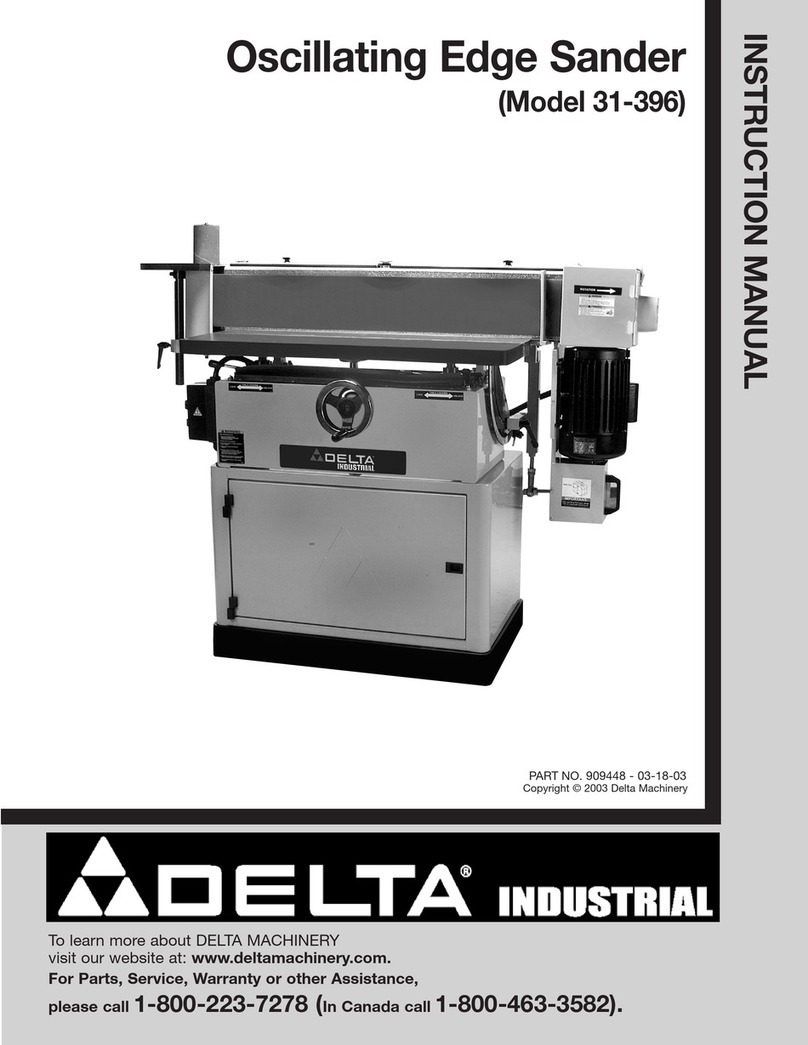
Delta
Delta 31-396 User manual
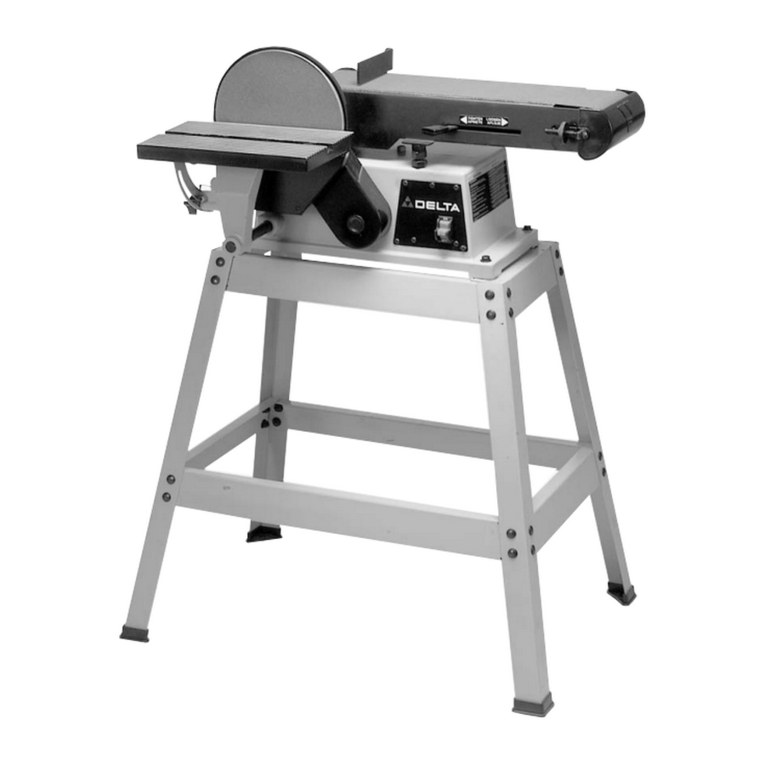
Delta
Delta 31-695 User manual

Delta
Delta 31-484 User manual
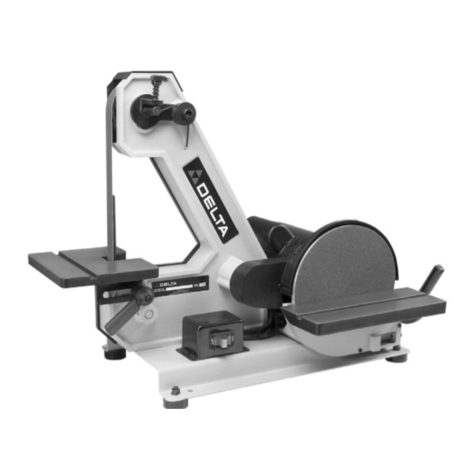
Delta
Delta 31-340 User manual

Delta
Delta 31-250 User manual
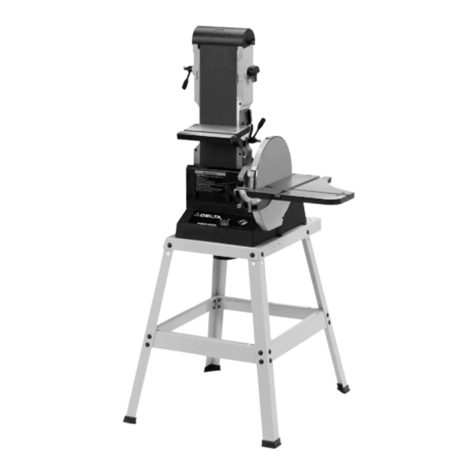
Delta
Delta 31-280 User manual

Delta
Delta 1'' BELT SANDER 31-050 User manual

Delta
Delta ShopMaster SA446 User manual
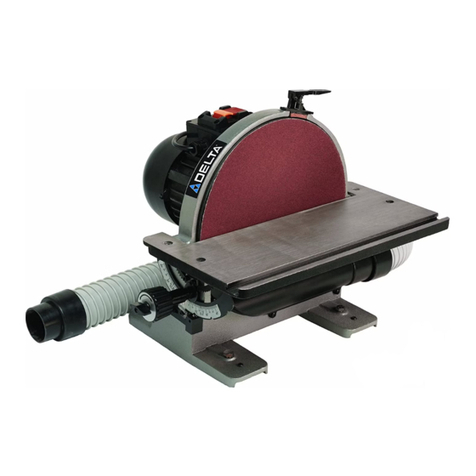
Delta
Delta 31-140 Service manual

Delta
Delta 31-483 Service manual

Delta
Delta 31-695 User manual
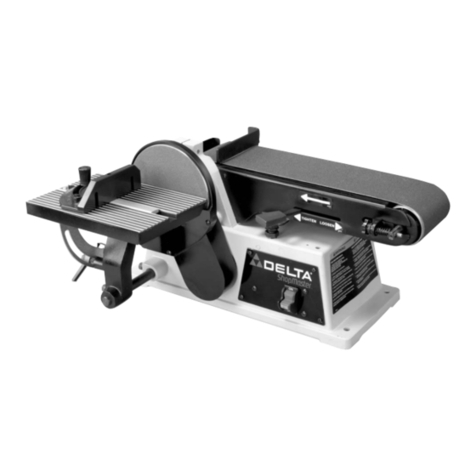
Delta
Delta ShopMaster SA446 User manual
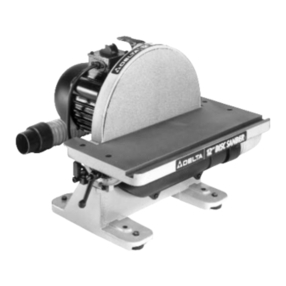
Delta
Delta 31-120 User manual
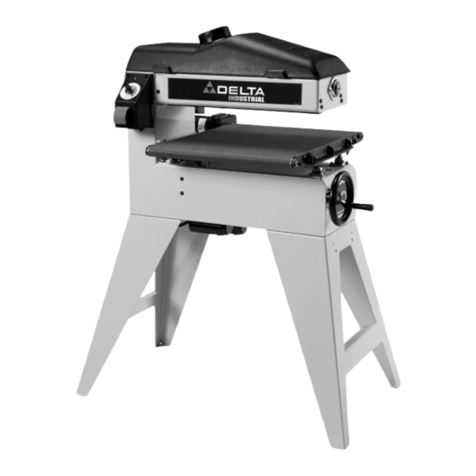
Delta
Delta 31-250 User manual

Delta
Delta 31-260X User manual
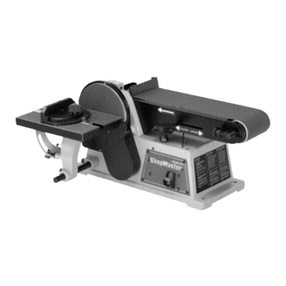
Delta
Delta ShopMaster 491836-00 User manual

Delta
Delta Rockwell International 31-200 Manual
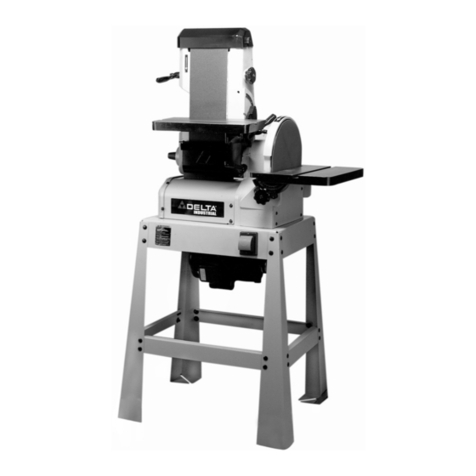
Delta
Delta (Model 31-300) User manual
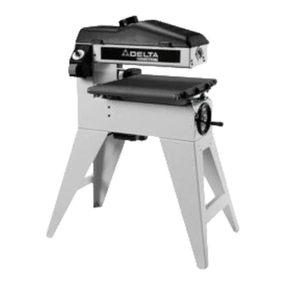
Delta
Delta 31-255x User manual
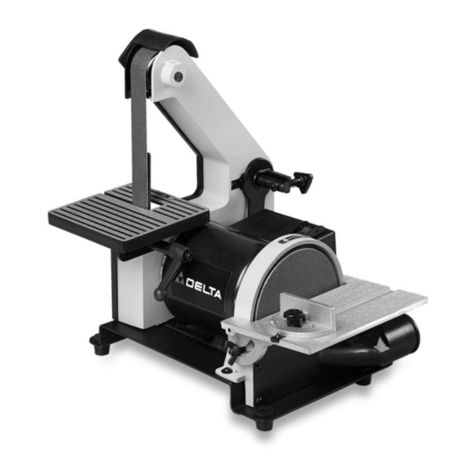
Delta
Delta 31-080 User manual
